#so the whole who has a right to a certain narrative gets complicated very fast
Explore tagged Tumblr posts
Text
imautfan
Hey! Greek person here This game grossly appropriates my culture Please consider avoiding such games in the future. If you're really interested in Greek mythology however you could try to find ones that were made by a Greek production company
Don’t get me wrong here, I do think we have to be careful when we deal with cultures that are not our own and make sure that we aren’t disrespectful of them and personally, I also think we should have more diverse creators.
But Greek mythology as such is not the property of the modern Greek nation-state. Not only is the history of Ancient Greece far more complicated than that (the Italian peninsula says hello), Greek mythology has also been an cornerstone of Western art and literature for many centuries, to the point that you have to know Greek mythology in order to understand what is happening in many of the most famous works of art and literature. Should all of that be considered appropriation, as well, and should we get rid of it because of that? Are people not allowed to tell these stories because they aren’t born in Greece?
I don’t think that is a productive way to go about it, because it usually also leads to a fight about who is interpreting the mythology “correctly” (which is extremely unproductive, as one of the cornerstones of mythology is literally the diversity in narratives) and I have better things to do with my day.
I mean yes, we can talk about whether they used Greek mythology in a really disrespectful way, but I’ve played the game for only like two hours, so I can’t meaningfully contribute to that. (Unless you specifically object to the setting of the game in Hades, because if you don’t like that premise, then you probably won’t like the rest of the game.)
#kuro answers#imautfan#not to bring scholarly discourse into this#but I wrote my disseration about mythology and it's generally difficult to cleanly separate narratives#(not) surprisingly a lot of mythologies borrow from others#it's like A Thing with stories#so the whole who has a right to a certain narrative gets complicated very fast#and additionally complicated by the creation of modern day nation states#but noone wants to hear me talk about this so I'm shutting up now
7 notes
·
View notes
Text
✨THEORY TIME - DEUXMOI IS WORKING WITH LUKE AND NICOLA ✨
This is a newly formulated theory so bear with me and it's a long one.
We’ve all been under the assumption that DM is a bitch and actively working against Nicola and Luke this whole time, right?
What if we’ve been wrong?
DM, at this point in my opinion, knows about Nicola and Luke. I don’t think there’s any way they couldn’t have gotten something sent in by someone who managed to recognize them out and about. But we know that they have actively been pushing Jake and Nic and somewhat Luke and Antonia with the same tired ass pictures.
Here’s what I propose: DM has actually been working with Nicola and Luke this whole time.
Now, hear me out! Do you guys remember DM posting those tips about Luke during the WT? The flight attendant story and the chaos dinner housewife one, too? I’ve always thought this was someone on his side attempting to break the idea that Nic and Luke were something more than friends/coworkers. What if they caught wind of that, who was doing it and decided to use it to their advantage?
I’m of the opinion that Antonia was a cover. Have been for a long while and I think this was set up sometime around Brazil with the liking spree he went on. It made it appear like she was someone important in the mix which is what would be needed to make a convincing cover, right? I think plan was set in place for her to be at the London premiere, go to events and be pictured with Luke and let it die out.
Girl went rogue though and other hands got involved and DM had to run with the pictures even with Luke looking mad as hell and his team had to sign off (possibly signed off BEFORE the hand hold pics were taken) on the pics with the “rumored girlfriend” tagline. This might have complicated shit, made people upset and it backfired horribly but there was no way to get out of it with the People’s article coming out the very next morning.
We see what we see for the next few weeks. Luke looks like a hostage, Antonia is getting some exposure and a whole lot of hate and Nic is seemingly just going about her business.
Sorrento happens. The LA pool pics were a joke and never picked up with he long ass photo shopped thumbs so they agreed to one more pap opportunity. He holds her and gets out. The entire time his friend group is posting him in stories and deleting, acting smug because they know he’s agreed to get papped and they got all high and mighty thinking this meant they were able to do the same. I think that’s where the breakdown happened.
We fast forward to the festival pics with Nicola. She’s papped with Jake, looking touchy and affectionate with this dude (who appeared on DM twice before that around the time Sorrento was going on or just after and those pub pics were taken by a friend imo) and it takes a ton of people out. Tbh I’ve always thought these were staged. They look posed in certain areas and the fact that Nic was rocking her giant claddagh in clear view of the camera was a clue for me.
They DO NOT expect this to spiral out of control and create an entire subfandom and the pap pics that come out after are not within their control. Jake is noticeably stiff and dead in the face and Nic seems upset in these pictures but DM pushes it.
They push the Jake narrative A LOT. But why?
Because Jake is actively helping Nic and Luke.
Why do we only get the same old recycled June 13th pap pics with Luke and Antonia? Because Antonia is not helping and working against Nic and Luke. That’s why DM doesn’t really seem to give much of a shit about her. But they can’t just drop her. She’s still part of a cover. So they use old pics, never really answer questions about her and the tips submitted about her never go anywhere.
Nicola has said twice that DM was not to be trusted. Did she say this to prepare people for Antonia’s presence? Personally I think the festival pics were set up after the fact, after Luke was getting tons of hate and weird fucking people trying to get in to his personal business and calling him terrible things that could greatly impact his name and reputation. So Jake was intentionally added into the idea that DM is a liar (which she is by nature) as well.
People might wonder why on earth though DM would be helping Nic and Luke by pushing these other “relationships” but imagine the dollar signs DM would be seeing if they were to be the first to drop the exclusive on them?
If DM is helping, they’re likely getting huge kickback for having to deal with us fans who believe they’re out to smear Nic and Luke’s names.
Now there are tons of holes in this theory but I literally thought of it this morning and decided to punch it out real quick. Let’s discuss!
122 notes
·
View notes
Note
Hi. I’m curious. What did you mean by “women who read fiction might get Bad Ideas!!!” has just reached its latest and stupidest form via tumblr purity culture.? I haven’t seen any of this but I’m new to tumblr.
Oh man. You really want to get me into trouble on, like, my first day back, don’t you?
Pretty much all of this has been explained elsewhere by people much smarter than me, so this isn’t necessarily going to say anything new, but I’ll do my best to synthesize and summarize it. As ever, it comes with the caveat that it is my personal interpretation, and is not intended as the be-all, end-all. You’ll definitely run across it if you spend any time on Tumblr (or social media in general, including Twitter, and any other fandom-related spaces). This will get long.
In short: in the nineteenth century, when Gothic/romantic literature became popular and women were increasingly able to read these kinds of novels for fun, there was an attendant moral panic over whether they, with their weak female brains, would be able to distinguish fiction from reality, and that they might start making immoral or inappropriate choices in their real life as a result. Obviously, there was a huge sexist and misogynistic component to this, and it would be nice to write it off entirely as just hysterical Victorian pearl-clutching, but that feeds into the “lol people in the past were all much stupider than we are today” kind of historical fallacy that I often and vigorously shut down. (Honestly, I’m not sure how anyone can ever write the “omg medieval people believed such weird things about medicine!” nonsense again after what we’ve gone through with COVID, but that is a whole other rant.) The thinking ran that women shouldn’t read novels for fear of corrupting their impressionable brains, or if they had to read novels at all, they should only be the Right Ones: i.e., those that came with a side of heavy-handed and explicit moralizing so that they wouldn’t be tempted to transgress. Of course, books trying to hammer their readers over the head with their Moral Point aren’t often much fun to read, and that’s not the point of fiction anyway. Or at least, it shouldn’t be.
Fast-forward to today, and the entire generation of young, otherwise well-meaning people who have come to believe that being a moral person involves only consuming the “right” kind of fictional content, and being outrageously mean to strangers on the internet who do not agree with that choice. There are a lot of factors contributing to this. First, the advent of social media and being subject to the judgment of people across the world at all times has made it imperative that you demonstrate the “right” opinions to fit in with your peer-group, and on fandom websites, that often falls into a twisted, hyper-critical, so-called “progressivism” that diligently knows all the social justice buzzwords, but has trouble applying them in nuance, context, and complicated real life. To some extent, this obviously is not a bad thing. People need to be critical of the media they engage with, to know what narratives the creator(s) are promoting, the tropes they are using, the conclusions that they are supporting, and to be able to recognize and push back against genuinely harmful content when it is produced – and this distinction is critical – by professional mainstream creators. Amateur, individual fan content is another kettle of fish. There is a difference between critiquing a professional creator (though social media has also made it incredibly easy to atrociously abuse them) and attacking your fellow fan and peer, who is on the exact same footing as you as a consumer of that content.
Obviously, again, this doesn’t mean that you can’t call out people who are engaging in actually toxic or abusive behavior, fans or otherwise. But certain segments of Tumblr culture have drained both those words (along with “gaslighting”) of almost all critical meaning, until they’re applied indiscriminately to “any fictional content that I don’t like, don’t agree with, or which doesn’t seem to model healthy behavior in real life” and “anyone who likes or engages with this content.” Somewhere along the line, a reactionary mindset has been formed in which the only fictional narratives or relationships are those which would be “acceptable” in real life, to which I say…. what? If I only wanted real life, I would watch the news and only read non-fiction. Once again, the underlying fear, even if it’s framed in different terms, is that the people (often women) enjoying this content can’t be trusted to tell the difference between fiction and reality, and if they like “problematic” fictional content, they will proceed to seek it out in their real life and personal relationships. And this is just… not true.
As I said above, critical media studies and thoughtful consumption of entertainment are both great things! There have been some great metas written on, say, the Marvel Cinematic Universe and how it is increasingly relying on villains who have outwardly admirable motives (see: the Flag Smashers in The Falcon and the Winter Soldier) who are then stigmatized by their anti-social, violent behavior and attacks on innocent people, which is bad even as the heroes also rely on violence to achieve their ends. This is a clever way to acknowledge social anxieties – to say that people who identify with the Flag Smashers are right, to an extent, but then the instant they cross the line into violence, they’re upsetting the status quo and need to be put down by the heroes. I watched TFATWS and obviously enjoyed it. I have gone on a Marvel re-watching binge recently as well. I like the MCU! I like the characters and the madcap sci-fi adventures! But I can also recognize it as a flawed piece of media that I don’t have to accept whole-cloth, and to be able to criticize some of the ancillary messages that come with it. It doesn’t have to be black and white.
When it comes to shipping, moreover, the toxic culture of “my ship is better than your ship because it’s Better in Real Life” ™ is both well-known and in my opinion, exhausting and pointless. As also noted, the whole point of fiction is that it allows us to create and experience realities that we don’t always want in real life. I certainly enjoy plenty of things in fiction that I would definitely not want in reality: apocalyptic space operas, violent adventures, and yes, garbage men. A large number of my ships over the years have been labeled “unhealthy” for one reason or another, presumably because they don’t adhere to the stereotype of the coffee-shop AU where there’s no tension and nobody ever makes mistakes or is allowed to have serious flaws. And I’m not even bagging on coffee-shop AUs! Some people want to remove characters from a violent situation and give them that fluff and release from the nonstop trauma that TV writers merrily inflict on them without ever thinking about the consequences. Fanfiction often focuses on the psychology and healing of characters who have been through too much, and since that’s something we can all relate to right now, it’s a very powerful exercise. As a transformative and interpretive tool, fanfic is pretty awesome.
The problem, again, comes when people think that fic/fandom can only be used in this way, and that going the other direction, and exploring darker or complicated or messy dynamics and relationships, is morally bad. As has been said before: shipping is not activism. You don’t get brownie points for only having “healthy” ships (and just my personal opinion as a queer person, these often tend to be heterosexual white ships engaging in notably heteronormative behavior) and only supporting behavior in fiction that you think is acceptable in real life. As we’ve said, there is a systematic problem in identifying what that is. Ironically, for people worried about Women Getting Ideas by confusing fiction and reality, they’re doing the same thing, and treating fiction like reality. Fiction is fiction. Nobody actually dies. Nobody actually gets hurt. These people are not real. We need to normalize the idea of characters as figments of a creator’s imagination, not actual people with their own agency. They exist as they are written, and by the choice of people whose motives can be scrutinized and questioned, but they themselves are not real. Nor do characters reflect the author’s personal views. Period.
This feeds into the fact that the internet, and fandom culture, is not intended as a “safe space” in the sense that no questionable or triggering content can ever be posted. Archive of Our Own, with its reams of scrupulous tagging and requests for you to explicitly click and confirm that you are of age to see M or E-rated content, is a constant target of the purity cultists for hosting fictional material that they see as “immoral.” But it repeatedly, unmistakably, directly asks you for your consent to see this material, and if you then act unfairly victimized, well… that’s on you. You agreed to look at this, and there are very few cases where you didn’t know what it entailed. Fandom involves adults creating contents for adults, and while teenagers and younger people can and do participate, they need to understand this fact, rather than expecting everything to be a PG Disney movie.
When I do write my “dark” ships with garbage men, moreover, they always involve a lot of the man being an idiot, being bluntly called out for an idiot, and learning healthier patterns of behavior, which is one of the fundamental patterns of romance novels. But they also involve an element of the woman realizing that societal standards are, in fact, bullshit, and she can go feral every so often, as a treat. But even if I wrote them another way, that would still be okay! There are plenty of ships and dynamics that I don’t care for and don’t express in my fic and fandom writing, but that doesn’t mean I seek out the people who do like them and reprimand them for it. I know plenty of people who use fiction, including dark fiction, in a cathartic way to process real-life trauma, and that’s exactly the role – one of them, at least – that fiction needs to be able to fulfill. It would be terribly boring and limited if we were only ever allowed to write about Real Life and nothing else. It needs to be complicated, dark, escapist, unreal, twisted, and whatever else. This means absolutely zilch about what the consumers of this fiction believe, act, or do in their real lives.
Once more, I do note the misogyny underlying this. Nobody, after all, seems to care what kind of books or fictional narratives men read, and there’s no reflection on whether this is teaching them unhealthy patterns of behavior, or whether it predicts how they’ll act in real life. (There was some of that with the “do video games cause mass shootings?”, but it was a straw man to distract from the actual issues of toxic masculinity and gun culture.) Certain kinds of fiction, especially historical fiction, romance novels, and fanfic, are intensely gendered and viewed as being “women’s fiction” and therefore hyper-criticized, while nobody’s asking if all the macho-man potboiler military-intrigue tough-guy stereotypical “men’s fiction” is teaching them bad things. So the panic about whether your average woman on the internet is reading dark fanfic with an Unhealthy Ship (zomgz) is, in my opinion, misguided at best, and actively destructive at worst.
461 notes
·
View notes
Text
LGBTQ Game Review - A Summer’s End – Hong Kong 1986
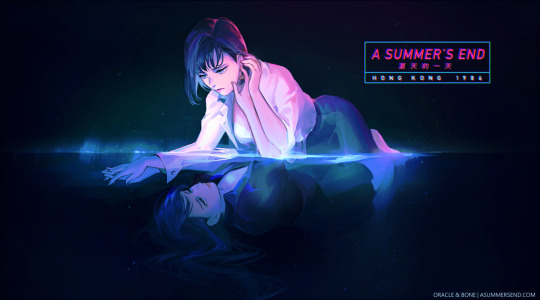
Before diving into the meat of Oracle and Bone’s A Summer’s End, I want to talk about the women behind this game Tida Kietsungden, and Charissa So. So and Kietsungden have done nothing but impress me since the announcement of A Summer’s End. They have repeatedly demonstrated their immense effort and dedication to creating a beautiful and thoughtful experience. Through conversations with the studio and reading their blog entries, I gained a remarkable understanding of how this game is both a tribute to classic cinema and a love letter to the Yuri and LGBT community. Through careful research and thoughtful expression, the two women navigate and acknowledge complicated issues, including Asian LGBTQ history and Hong Kong’s delicate political situation with grace and maturity. I am in complete awe of both women and their work. However, regardless of my profound respect for these creators, I still endeavor to offer my unfiltered thoughts on the visual novel, giving praise and criticism where appropriate.
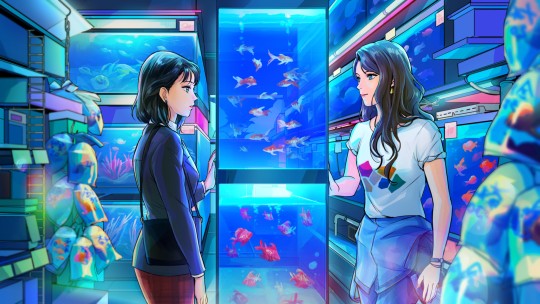
A Summer’s End – Hong Kong 1986 is a Yuri visual novel set, as you may have figured out, in Hong Kong in the year 1986. The game follows a young office worker, Michelle (Fong Ha) Cheung, who has a chance encounter with a free-spirited woman named Sam (Ka Yan) Wong. Both women feel drawn to each other, and the game explores this mutual attraction and the budding relationship which emerges from it.

This plot follows the standard girl meets girl story that has permeated the Yuri genre for the past several decades. Like most Yuri stories, the older and more experienced woman, Sam, is rebellious and beautiful, with long dark hair and a dominating persona. Michelle, although far more naive in the ways of love, breaks the trend of this trope by being the more sullen of the two. I would have liked to see the game diverge a bit more from the standard story of the genre. Fortunately, A Summer’s End is a romance story between adults who do not work together, setting it apart from the norms. It even includes a coming out section that creates a more robust LGBT identity than any tale of temporary schoolgirl love.
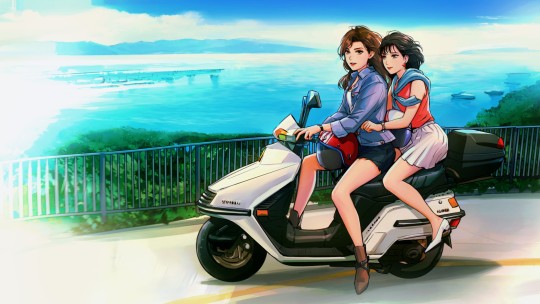
The story is well put together and well presented. The story is told primarily from Michelle’s perspective. It mostly takes place over a few days, during which Michelle engages in a whirlwind romance with Sam. This story features the struggle between her feelings and passion and her devotion to tradition and her mother. The progression of her affection is unrealistically fast. The story feels a bit rushed, and many of the societal and personal quagmires the game stumbles upon are not sufficiently developed or confronted. Had the game indulged in a more prolonged and tumultuous struggle for Michelle, conclusions would have felt much sweeter, and the story would have gone from good to great.
Even with this massive missed opportunity, there are plenty of exemplary moments and aspects of the narrative. The game pulls no punches addressing Michelle’s slightly overbearing mother and the conflict between the two. It would have been incredibly simple to take the easy route on this one. Still, the developers stuck to their guns and manage to explore a challenging situation satisfyingly, all while keeping the characters realistic and sympathetic. In fact, every scene relating to LGBT rights and history is flawlessly executed.
There are also some fantastic chapters, including a thrilling but refreshing bike ride and a flashback scene that recontextualizes certain events from another perspective. The many references and allusions to classic cinema including some older lesbian films and plenty of Asian works, are particularly noteworthy. However, the best part of A Summer’s End by far is the setting.
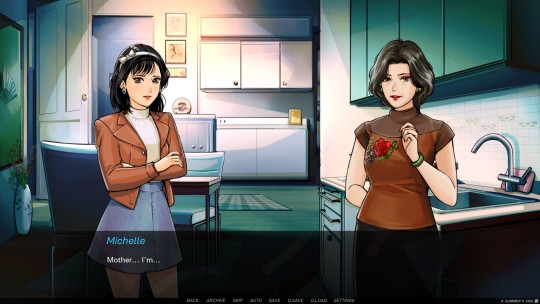
The location and time period is intrinsic to Sam and Michelle’s tale, as it is shaped by and reflects contemporary culture and LGBTQ rights. Oracle and Bone create a vibrant and lively world, a jaw-dropping depiction of Hong Kong in the 1980s. Everything helps feed into the creation of this world, including a fantastic and retro UI, small touches such as a Cantonese subway announcement, and objects encountered like a disposable camera help convey a strong sense of the period. However, the soundtrack sells it more than any other element, save perhaps the artwork, transporting the player to the era. While a few tracks are the standard easy listening affairs one expects from visual novels, there are tons of excellent city pop and disco beats, complete with plenty of synths and confidence! Finally, a visual novel soundtrack that contributes more than just background noise!

Sadly, the game’s dialogue choice system and branching paths are far more of a hindrance than a help. I can honestly say that the game would play better and be way more enjoyable as a kinetic novel. Most choices feel inconsequential, changing nothing of the story and resulting in almost the exact same response from other characters yet, they have a hidden points system. If you do not earn enough points, parts of the optional adult content will be unplayable until one goes back to find the right choice. I spent several hours replaying, and eventually skipping through, the game to unlock all the scenes, and finally gave up with one CG left unseen. The only choice with any actual effect is painfully evident in its consequences. One option leads to the bad ending, which is well written, but no reasonable player would go down that path unless they just wanted to see the whole game. The second unveils the true good ending, which no player in their right mind would not pursue, as again, the choice is obvious and adds nothing to the game. There is no reason to put in an alternative ending or tedious dialogue choice.
The characters in A Summer’s End are well constructed. Sam is adventurous without being obnoxious and has a mature though appropriately unrefined demeanor. Michelle is extremely curt and somewhat distant, although she displays a sharp wit and more timid nature on occasion. Both women participate in engaging, deep, and thoughtful discussions, often with each other, although sometimes internally, and thus feel well developed and complex. Unfortunately, their chemistry, while not absent, is not enough to sell the whirlwind romance. There is insufficient expression of their feelings and attractions, both internally or through dialogue and actions, so their inevitable closeness feels unearned.
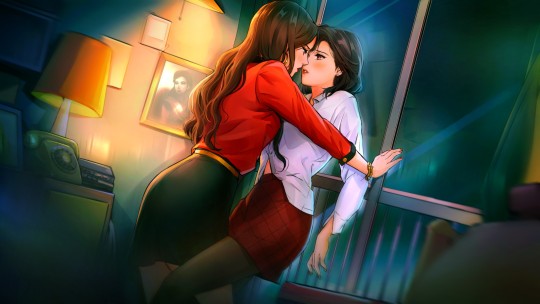
However, even in the short game, both characters change with each other, especially Michelle, as she becomes more affectionate, confident, and caring. She begins to embody some of Sam’s warmness while never losing herself. Some of my favorite dialogue and interaction came from her towards the end of the game, although I will not spoil it. Additionally, side characters have a strong presence thanks to their firmly established characteristics and a profound effect on the narrative. Each has their own sprite and mannerisms, helping cement them as fixtures in A Summer’s End rather than tacked on assets.
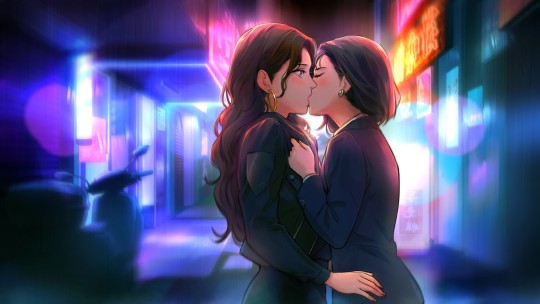
The visual novel contains optional adult content, which is installed in an extra patch and can be toggled on and off. I played through the game with and without it and can happily report that the story is just as fulfilling and complete without it. Although the unlockable nature of these scenes is aggravating, they are very well written and sensual without being exploitative. There were moments I did not care for as much, such as Sam getting carried away at one point, but it felt very realistic and incredibly sensual. The artwork in these sexual encounters is some of the best in the game, embracing darker colors and showcasing intense desire.
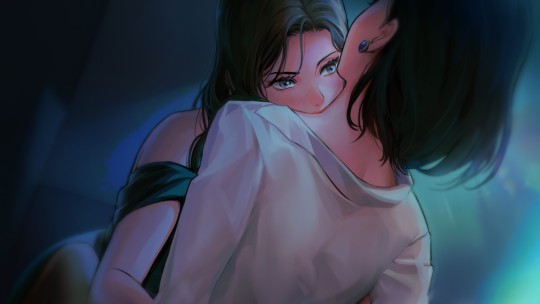
Speaking of the artwork, it is stupendous. The game is bright and striking, with amazing backgrounds complete with luminous neon signs, glaring televisions, and life and activity oozing from every corner. The backgrounds are so beautiful and detailed they could effectively serve in place of CG art, although there is plenty of that asides. The character models and designs are similarly excellent, with expressive poses and faces. The various outfits, of which the game has many, embody iconic 80’s fashion. Artist Tida Kietsungden draws both the characters and CGs with a distinctive hand-drawn style, which allows them to play well off each other and add to the beautiful presentation. The detail and care that went into the aesthetics are enormous and elevate the game at every moment.
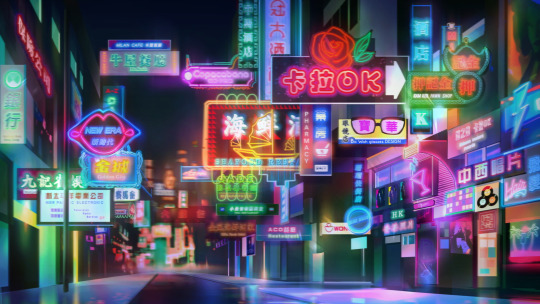
A Summer’s End – Hong Kong 1986 is a vibrant and intimate experience. The fantastic setting and flawless artwork surround a compelling and thoughtful story about lesbian love and desire, societal expectations, and the bonds between family and lovers. It is rough around the edges, with a slightly rushed story that leaves little time to wallow in complexity and an awful dialogue system. However, it will win players over with its striking presentation and sophisticated subject matter. I look forward to more from this studio and highly recommend you check this game out!
Ratings: Story – 7 Characters – 6 Art – 10 Music – 8 LGBTQ – 8 Sexual Content – 3 (8 with patch) Final – 7
Purchase A Summer’s End on Steam and itch.io, available April 23
Consider supporting Yuri news, reviews, and content on the YuriMother Patreon
#Yuri#lgbt#lgbtq#lgbtq+#queer#gay#reivew#a summer's end#hong kong#girls love#gl#wlw#lesbian#visual novel#games#video games#gaming#manga#anime#reviews
2K notes
·
View notes
Text
Capsule Reviews, February 2021
Here's some things I've been reading.
The Curse of Brimstone
DC's New Age of Heroes books, emerging from the beginning of Scott Snyder's creative-flameout-as-crossover-event Metal, mostly constituted riffs on Marvel heroes like the Fantastic Four (in The Terrifics) or the Hulk (in Damage). The Curse of Brimstone is a riff on Ghost Rider. It's... uneven. The first volume is generally pretty good, and when Phillip Tan is drawing it, as he does the first three and a half issues, it's gorgeous and unique, when he departs though, the quality takes a nose dive. None of the replacement artists, including the great Denis Cowan, can quite fill his shoes, and the story gets old fast. Guy makes a deal with the devil (or rather, a devil-like inhabitant of the "Dark Multiverse" as a not horribly handled tie-in to the conceits of Metal), realizes it's a raw deal, and rebels. The characters are flat, lots of time is spent with the main character's sister haranguing him to not use his powers (it is, in my humble opinion, something of a cardinal sin to have a character whose primary role is telling other characters to stop doing interesting things), too many potboiler "I know you're still in there!/I can feel this power consuming me!" exchanges, a couple of underwhelming guest spots (including a genuinely pointless appearance by the old, white, boring Doctor Fate) too many flashbacks, and not enough of the action. There's potential in the classic demonic hero rebelling plotline and its link to the liminal spaces of the DC universe, forgotten towns and economic depression, but the wheels come off this series pretty much as soon as Tan leaves. The really disappointing this is that the series is clearly built as an artistic showcase, so after Tan's shockingly early departure, the main appeal of the series is gone and there's nothing left but the playing out of an obviously threadbare story.
Star Wars - Boba Fett: Death, Lies, and Treachery
I don't care much about Star Wars these days, and I think that most of the old Expanded Universe was, as evidenced by Crimson Empire, pretty bad. Death, Lies, and Treachery, is that rare Star Wars EU comic which is actually good. John Wagner writes and he's in full-on 2000 AD mode, writing Boba Fett as a slightly more unpleasant Johnny Alpha (who is like a mercenary Judge Dredd, for those unfamiliar) right on down to the appearance of a funny alien sidekick for one of the characters. The main attraction is Cam Kennedy's art though, along with his inimitable colors: this might be the best looking Star Wars comic ever. The designs are all weird and chunky, with an almost kitbashed feeling that captures the lived in aesthetic of classic Star Wars, and the colors are one of a kind. Natural, neutral white light does not exist in this comic, everything is always bathed at all times in lurid greens or yellows, occasionally reds, and it looks incredible. In terms of "Expanded Universe" material for Star Wars, this hits the sweet spot of looking and feeling of a piece, but exploring the edges of the concept with a unique voice. It's great. I read this digitally, but I'd consider it a must-buy in print if I ever get the chance at a deal.
Zaroff
Zaroff is a French comic (novel? novella?). It's like 90 pages and it delivers exactly on its premise of "Die Hard starring the bad guy from The Most Dangerous Game." It's pretty good. Count Zaroff, he of the habitual hunting of humans, turns out to have killed a mafia don at some point, and after miraculously escaping his own seeming death at the end of the original story, finds himself hunted by the irate associates of this gangster, who have brought along Zaroff's sister and her kids to spice things up. Zaroff not only finds himself the hunt, but he also has to protect his estranged family as they struggle to survive. Nothing about this book or its twists and turns is likely to surprise you, but I don't think being surprised is always necessary for quality. Zaroff delivers on pulpy, early-20th century jungle action, is gorgeously rendered, and the fact that Zaroff himself is an unrepentant villain adds just enough of an unexpected element to the proceedings and character dynamics that it doesn't feel rote. There's a couple of points, ones typical of Eurocomics, which spark a slight sour note, such as some "period appropriate" racism and flashes of the male gaze, but for the most part these are relatively contained. It's good.
Batman: Gothic
Long before Grant Morrison did their Bat-epic, they wrote Batman: Gothic, an entirely different, but then again maybe not so different, kind of thing. It starts off with what must be called a riff on Fritz Lang's film, M, only where that story ends with a crew of gangsters deciding they cannot pass moral judgment on a deranged child-murderer, in Morrison's story they go ahead and kill him, only for the killer to return years later to rather horribly murder all of them as a warmup for a grandiose scheme involving unleashing a weaponized form of the bubonic plague on Gotham City as an offering to Satan. Along the way it turns out that said villain, one Mr. Whisper, is a former schoolmaster of Bruce Wayne's, who terrified the young Batman in the days before his parent's deaths. It's an earlier Morrison story and it shows. Certain elements presage their later Batman work; Mr. Whisper as a satanic enemy recalls the later Doctor Hurt, and the cathedral Mr. Whisper built to harvest souls recalls what writers like Morrison, Milligan, and Snyder would do concerning Gotham as a whole years later.The art, by Klaus Janson, is spectacular. If you're familiar at all with his work collaborating with Frank Miller you'll see him continuing in a similar vein and it's all quite good, even when he stretches beyond the street milieu which most readers might know him from. There's one particular sequence where Janson renders a needlessly complicated Rube Goldberg machine in motion that manages to work despite being static images. The writing by Morrison though, is not their finest. The M riff doesn't last as long as it could, and Mr. Whisper's turn in the latter half of the story from delicious creepy wraith to a cackling mass murderer who puts Batman in an easily escaped death trap feels like something of a letdown from the promise of the first half of the book. Gothic is good, but not, in my opinion, great. It's certainly worth checking out for Morrison fans however, and I imagine that someone well-versed in his latter Batman stuff might be able to find some real resonance between the two.
Green Arrow: The Longbow Hunters
For a long, long time, Longbow Hunters was THE Green Arrow story. It is to Green Arrow as TDKR is to Batman, deliberately so. Mike Grell wrote and drew the reinvention of the character from his role as the Justice League's resident limousine liberal to a gritty urban vigilante operating in Seattle over the course of these three issues, which he'd follow up with a subsequent ongoing. Going back to it, it certainly merits its reputation, but its far from timeless. Grell's art is unimpeachable absolutely incredible, with great splashes and spreads, subtle colors, and really great figure work. The narrative is almost so 80's it hurts though, revolving around West Coast serial killers, cocaine, the CIA and the Iran-Contra scandal, and the Yakuza, and it's hard to look back at some of this stuff without smirking. The story begins with a teenager strung out on tainted coke sprinting through a window in a scene that's right out of Reefer Madness. In the cold light of a day 30+ years later, parts of it look more than a little silly. The 80's-ness of it all doesn't stop with that stuff though, even the superhero elements smack of it. Green Arrow realizes that he's lost a step and has be to be shown a way forward by an Asian woman skilled in the martial arts (recalling Vic Sage's reinvention in the pages of The Question), and Black Canary gets captured and torture off-panel for the sake of showing that this is real crime now, not the superhero silliness they've dealt with before. The treatment of Black Canary here is pretty markedly heinous, it's a classic fridging and Grell's claims that he didn't intentionally imply sexual assault in his depiction of her torture is probably true, but still feels more than a little weak considering how he chose to render it.The final analysis is that this book is good, but it exists strictly in the frame of the 1980's. If you're a fan of Green Arrow, there are worse books to pick up, or if you're interested in that era of DC Comics it's more than worth it, but as a matter of general interest I wouldn't recommend it very highly.
SHIELD by Steranko
Jim Steranko is sort of the prodigy of the early Marvel years, a young guy who came up through the system, blossomed into an incredible talent, and then left the company, and by and large the industry, behind. He would go on to dabble in publishing, work in other mediums, and generally kick around as the prodigal son of Marvel Comics. This collection, of both his Nick Fury shorts in the pages of Strange Tales and the four issues he drew of the original Nick Fury solo series, charts Steranko's growth as an artist. The book starts off with Steranko working from Jack Kirby's layouts with Stan Lee's dialogue and writing, and Steranko might be the one guy in history for whom working off of Kirby's blueprints is clearly holding him back. The first third or so of this collection really isn't much to write home about, as Steranko is obviously constrained by someone else's style, and at the end of the day those early stories still read as somewhat uninspired pulp compared to the highlights of early Marvel. There are flashes though, of techniques and ideas, which foreshadow what Steranko is capable of, and when he finally takes over as solo writer/artist it's like he's been unleashed. He immediately has Nick Fury tear off his shirt and start throwing guys around over psychedelic effects. He writes out most of Kirby and Lee's frankly uninspired boys' club supporting cast, he makes Fury visibly older, wearier, but also so much cooler. It's the birth of Nick Fury as a distinctly comic book super spy.By the time he finishes wrapping up the previous writers' plotline with Hydra and Baron von Strucker, Steranko is firing on all cylinders. By the time it gets to Steranko's Fury solo series, he's somehow surpassed himself, turning in effects, panel structures, and weird stories which make the earlier installment about a suit-wearing Man from UNCLE knockoff and its strict six-panel layouts look absolutely fossilized.I can't recommend this collection highly enough for any fan of the artform, even if the stories themselves might not be everyone's cup of tear. It's truly incredible to watch Steranko emerge as an artist over the course of this single collection. The book itself has a few problems, it's not the most elegantly designed in its supporting materials and index, but the content of it more than outweighs that. It's great stuff.
3 notes
·
View notes
Text
RWBY and Masculinity
I love RT’s, and specifically RWBY’s take on masculinity so much. The show subverts all expectations wrt their male characters and their development, which is why the male viewers experience major cognitive dissonance between what they expect and what story is actually being told (and then have the gall to call it bad writing). Under cut because this has gotten so long so fast.
The two main male characters - Sun and Jaune - are subvertions of genre/medium staples.
Jaune specifically hits all the beats of the typical male self-insert in a harem anime: he’s catapulted into a world he knows nothing of, instantly establishes 3 different dynamics with 3 different female characters/archetypes - Cheery, Ice Princess and Hot Tall and Earnest - one of whom he immediately sets his eyes on, he’s surrounded by women that are a whole lot more powerful than he is (and arguably THE most powerful one is instantly drawn to him), he’s essentially powerless and dealing with self-esteem issues and is nondescript enough to be a vehicle for any male viewer to project themselves onto. Which is why you have a good chunk of Jaune’s fandom from V1 being the embodiment of the Venn diagram intersection bewteen weebs and incels like That, and why there’s so much harem fanfic revolving around Jaune.
CRWBY have heavily drawn from anime when making rwby so I don’t think this was coincidental; they laid out the groundworks to subvert a specific trope. Male fans, however, bought into the facade and kept waiting for Jaune to essentially steal the spotlight, be the focal point of several love interests and get a power up that’ll let him be their own power fantasy to boot, but CRWBY took his character in the very opposite direction.
Jaune makes a lot of mistakes but what defines him is how earnestly he learns from them and redeems himself. He apologizes for lashing out at Pyrrha as a result of his own feelings of inadequacy and powerlessness when bullied by Cardin and then accepts her offer to teach him, sincerely taking instruction from her and then taking inspiration from her strength. Once he realizes his seduction skit with Weiss is not only ridiculous but wrong, he instantly changes his approach and prioritizes Weiss’s wants and needs over his, giving her space and knocking sense into Neptune so that Weiss can have her “ideal” date. Jaune doesn’t get embittered about being essentially rejected and most importantly he doesn’t let it affect his relationship with Weiss. Both of them become actual friends from that point on, and we get to see Jaune develop a certain measure of emotional intelligence starting that moment, which becomes part of his skillset and is shown to be part of what makes him a good leader. One of the best examples is how he and Ruby team up in V6E1 to get the hunter on the train to turn the turrets off. Jaune heals the hunter’s wounded arm and gently assuages his fear, in clear contrast with Qrow abrasively manhalding an injured and panicked man and expecting him to comply. The writing essentially puts down the show of arms and props up Ruby and Jaune’s approach; Jaune specifically is the example of masculine leadership the writing looks favorably on.
And that’s the kicker here: Jaune’s strength comes from his set of soft skills as opposed to traditionally portrayed masculine strength, which usually careens into toxic power fantasy land. His whole arc in V1-3 is about learning to shed any distorted notions of chivalry and strength and knowing that his end goal shouldn’t be to become a hero for the sake of it or to live up to societal expectations, but to do what he can and as good as he can for the sake of everyone. Jaune is a good strategist and he knows how to make the best out of everyone’s powers. He’s there to enhance how people use their semblances together. His big power-up, his semblance reveal is basically him getting confirmed for a cross between a cleric and a paladdin (DnD players amongst us please correct me if I’m wrong): he is the ultimate support, acting as a healer and an amplifier to everyone around him, and that’s why he’s a good leader. His power on his own loses its entire meaning: Jaune takes strength from the people he loves and endlessly, earnestly gives back to them, never once stealing the spotlight in combat because that’s not his role and that’s okay.
And as for Jaune’s romantic prospects, think Forever Fall established once and for all that Jaune’s already found the One and I don’t think we’ll see him get any other love interest, especially now that arkos parallels oz/salem and with how vehement CRWBY are about lancaster being platonic.
Now Sun. I want to tackle a specific expectation I’ve seen from male fans and that’s about him becoming more significant to the plot by coleading/leading the new White Fang movement...which would be hijacking Blake’s storyline. Blake is the one with drive and a cause, she was literally born inside the movement and has since seen it get derailed AND was the one to reclaim it from Adam and give it a new vision, as opposed to Sun who apparently wasn’t even aware of the systematic oppression Faunus had to deal with on a daily basis outside of Vacuo. So why is Sun, who has exactly 0 qualifications for this job and no interest in it, still expected to get it by a good chunk of his fans? Aside from the pervasive misogyny permeating fandom culture, there’s a specific trope media has served to us for decades now and that’s of a Semi-Competent Male Hero with his Hyper-Competent Female Side-kick (Vox published an article about it a few years ago and I really recommend checking it out), where a male character who’s semi good at best and not nearly as well-versed into whatever field he shares with his infinitely more competent female sidekick somehow walks in and saves the day and most of the time the female sidekick also, unsurprisingly doubles as a love interest. Time and again, male characters get rewarded for being half as good as their female counterpart at best AND they get the girl most often than not.
But Sun’s whole character is, again, the very opposite of this. Sun never outweighs Blake on her own narrative (as is literal common sense) and shouldn’t be expected to. Sun actually gets schooled into the Faunus cause by his more competent female counterpart, Blake acting as his mentor and introducing him to the fight and why it matters. Blake and Sun basically reenact the plotline of Journey to the West (Sun quite literally references it by calling it a “Journey to the East”) a story whose main character is the legendary monkey king Sun Wukong, who’s the mythical figure Sun’s based on. Sun’s arc about finally knowing the cause and fighting for the right reasons happens thanks to Blake’s guidance - which Sun earnestly complies with and never questions because he knows she’s the expert and he doesn’t usurp that spot from her - and never overshadows her own narrative. Quite the opposite, it builds up to her own arc as a future leading figure of the WF and face of the Faunus cause by having her politicize someone who has no real stakes in this fight even though they should have.
And then even his endeavor with Blake as a love interest falls through, with their relationship getting entirely recontextualized in V4-5 where their dynamic gets rebuilt as a friendship. Incidentally, that’s when it finally starts actually developing, instead of being stuck in the V1-3 limbo of mutual fleeting attraction where they’re constantly missing each other’s cues because they literally do not understand each other on a fundamental level. V4-5 is when Blake understands Sun isn’t what she needs in a romantic partner, but she does need him as a friend and ally. And Sun, whose premise falls in line with the Nice Guy trope, actually subverts it: he never makes Blake’s emotional journey about him, never expects anything in return and gracefully bows out of the narrative (for the time being) without ever pressuring Blake into acknowledging or returning his feelings. He doesn’t agonize over the initial attraction not going anywhere and doesn’t expect to be rewarded for being a decent person; again Blake’s feelings and well-being are his priority because that’s what good friends do. Their relationship developing into a steady friendship is never a point of conflict between them, and it’s actually lived as a positive event for both.
And then, to top it off, CRWBY parsed together every bit of toxic masculinity and wrapped it into a power fantasy package and named the end result Adam Taurus, who’s the absolute worst abusive piece of shit. Adam is every single thing bad about men as a power structure: abrasive, entitled, controlling, takes violence as an indication of power and doesn’t take kindly to his leadership/vision being questionned. It’s not really coincidental that he steals the power seat from a woman and acts like he deserves it in any way. But male fans were so starved for their power fantasy fix and traditionally masculine cool calm collected and complicated male character that they were ready to minimize/outright ignore the abuse he’s put Blake through and just how awful a human being he was just to be able to hard project onto him. And CRWBY’s answer to that is basically this:

TL;DR: RT says if your masculinity isn’t humble, nurturing, supportive, compassionate, selfless and earnest then we don’t want it.
#rwby#my posts#jaune arc#sun wukong#me holding myself at gunpoint: why can't you say what you want in 5 sentences or less#my meta#@ incels watching rwby you've been bamboozled
2K notes
·
View notes
Text
Talks Machina Highlights - Critical Role C2E63 (May 21, 2019)
Sorry it’s late, guys. @eponymous-rose has narrowly avoided being blown away by tornadoes and I’ve narrowly avoided drowning in equally dangerous paperwork, so here we are at the end of all things. Preroll is post-its of donors for Red Nose Day.
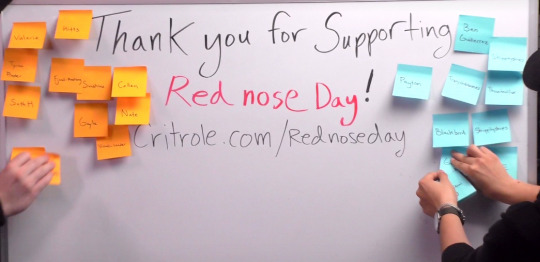
Tonight’s guests: Sam Riegel & Liam O’Brien.
Tonight’s announcements: We’re opened by Mark Hulmes instead of BWF. He dabs. No one blinks an eye. After the music open, we find out BWF’s neighbor’s kid stole his keys and then he lost his wallet. It hasn’t mattered, because he’s about to be Mr. Ashley Johnson & people just keep giving him what he needs. They’re still raising money for RedNoseDay. Thursday morning, the Colbert one-shot airs on the Critical Role Youtube. You can donate at critrole.com/rednoseday. Mark Hulmes joined Taliesin & BWF today for an episode available on the CR Twitch.
Episode 63: Intervention
CR Stats: Caleb cast his 700th spell, Gift of Alacrity, on Caduceus. Nott rolled her 40th natural 1 this episode to understand the local sewer system. This was Caduceus’s first HDYWTDT. Everyone mourns that someone stole the Golden Snitch from Matt’s bag.
It’s more stressful not knowing everyone’s motivations, both within the party and the game world. Sam talks about Yasha’s mysterious past and Beau’s dangerous ties to the Empire, especially given how much they understood in the first campaign about (at least) who the bad guys were. Sam feels like once they have a shred of information, he wants to jump on it ASAP and make big, bold decisions on them. He’s dealing with the discovery that this might be not as great an idea. He’s not experienced this kind of “trepidation, failure, uncertainty...I don’t like this game. I don’t like it at all!”
Caleb likes using the little bit of dunamantic magic as a taste of a drug--each little hit makes him want more and more and more.
Danimancy? Make a Carrcana check. Sigh, Sam.
Sam made two big mistakes in the last fight: he missed the gender of the dragonborn, so he thought that one of the other voices Matt was doing was actually the dragonborn giving orders (and therefore the one in charge, while the drow was the one taking orders). He also saw the dragonborn leaving and was worried that he was waiting on the party to give him (Nott) the go-ahead to kick things off. He recognizes he put Caleb in a terrible position both in a meta yes-and sense and in the Nott-Caleb team sense.
The world devolves into campaign slander and propaganda. Everyone’s in it, including BWF and Dani. #samforpresident
Caleb told the Brightqueen about his past because he feels like they’re on a very tight timeline, looking for very slight drips of information like gold. He thought it was worth the shot.
Sam desperately wants to know what the missing years in Yasha’s memory hold. BWF tells him to get what he can out of her while she’s here; her show’s been renewed for another season. He sounds genuinely bitter as he says it, but he notes at least it’s the last one. :(
They ask Mark Hulmes about what Charm does for people. He helpfully tells us it doesn’t say if they remember or not. Sam also points out Nott has blown up Caduceus before, so doing a few more points to Yasha is *wigglehands*.
Caleb did not mean to kill the horse on purpose. Sam tries to get him to confess that on camera, but instead Liam needles him about not cuddling Henry.
Cosplay of the Week: @andy_srivastava’s cosplay of Beau. Gorgeous!
Both Sam and Nott feel the fight’s outcome was his/her fault. He expects her to feel very guilty next week. Sam genuinely felt and still feels bad about it. He also prefers hashing out reactions the night things happen instead of having to wait a week for the next Thursday. He feels it’s more genuine.
Caleb is very worried about Jester’s mom and Astrid’s crew finding ways to use her mom as leverage. He’s also worried about the kid, but is glad Shakaste is going to get him. Liam also always imagined running into his old crew against the backdrop of the Empire, and is now very worried that if he runs into them soon he’ll have the added perception of being a traitor since they’re in the Dynasty.
Liam and Caleb both were surprised he was given hints of dunamancy so freely. He looks forward to learning more.
Liam totally understands how easy it is to miss things now. He’s constantly looking things up and reading in an attempt to understand his spells, and therefore missing parts of the battle. He greatly sympathizes with Marisha. Sam, on the other hand, is finding it hard to adapt to rogue life; he doesn’t like the necessary “out there, bold choice” nature of rogues in D&D and having the pressure of making big decisions very fast. He prefers Scanlan’s nature of sitting in the back, casting spells, and being more reactionary than instigatory. Liam always is afraid of picking the wrong spells, and finds it much harder than Vax. BWF: “Dagger dagger dagger...dagger dagger dagger dagger?” Liam: “I kept track of that fine, it’s everyone else that was wrong.”
Sam is shocked the D&D Beyond campaign bit has dragged on. BWF calls his rebuttal “bogusly weak,” and Sam looks genuinely aghast. It’s hilarious. “I don’t know how he got to you, Brian, but this feels like coming on Fox News! You’re a partisan hack! I won’t take it anymore, but I love attention, so I will stay.”
Nott is super interested in the dodeca’s ability to give people different bodies, but Caleb is still the clearest path to getting her body back. It’s complicated because the Dynasty souls are “chosen” and Nott’s not likely to be so.
Liam is very excited to see this magic system Matt has created in dunamancy. Did he create it in response to Liam or had he already thought about it? Sam tells us he’s always been thoughtful about fate and the subverting of it. Liam is so pumped because in campaign one, fate strings existed and were uncontrollable, but in campaign two we’ve “developed physicists, tinkering.”
In re: Essik, Nott’s just happy Caleb has found a friend. She wishes he’d bring him home more often.
Sam finally busses Henry’s cheek and affirms to us that he actually loves dogs. Everyone in his family is voting for a new dog except for his daughter, who wants a cat.
Liam doesn’t want everything to be cat-themed, but likes retouching a few spells here and there for flavor. He also wanted to differentiate it from Scanlan’s Bigby’s Hand. Sam thinks he should reskin more spells.
SPOILERS FOR C1 IN THIS QUESTION. Sam talks about rogue high-stakes moments as genuinely, surprisingly stressful. Liam says Vax was stressful but exhilarating, especially when it came to moments that conflated poor meta decisions vs roleplay decisions. He specifically mentions Raishan’s chase as a terrible in-game decision but one that was right for the character. He and Sam will always do what’s right for the character, even if it’s bad narratively in the moment. Sam says he got a lot of support from the group thread this past week, though. END SPOILERS FOR C1.
Fanart of the Week: a gorgeous Caduceus portrait by @larndraws.
Nott trusts Shakaste to get Luke traveling safely. Sam also drops a bombshell on the world by telling us Luc is spelled Luc. It’s just that no one’s ever asked. Heavens!
Caleb’s made an effort to tell people he cares for them, but he fears it at the same time. He’s afraid he’s going to be put in a position where he needs it too much. Brian asks if he believes he’s truly irredeemable: Liam says there’s a certain road where he could feel he atoned, and there’s a road that might lead to balance, but there’s never a brass ring that he could reach that could let him relax entirely. I don’t entirely understand the metaphor, but I get what he means.
Sam likes that the theme of this campaign seems to be “atonement and reconciliation” compared to the first campaign’s “finding family.” There’s a bit of that in this campaign too, but he likes how everyone has something in their past that they’re clinging to, and he’s interested to see who will be able to resolve it, who will be able to handle it, and who won’t be able to let it go.
Mark Hulmes come on to talk about the Stream of Descent, which happened last weekend. He’s the DM for High Rollers, which airs at 9am Pacific on Sundays.
BWF talks about how C1 had a lot of the Hero’s Journey in various forms, and C2 feels a lot like “what it means to be good.” He doesn’t feel they fit the “antihero” archetype very well.
Liam thinks that if Caleb were going to leave the campaign, he’d have done it already.
Part of Caleb’s generation was to create a character the world would shun, and seeing if he could find a way to find compassion for them. He mentions the poem written for the Boston marathon bomber a while ago. BWF talks about how it’s a really interesting character choice because it depends on the rest of the table being willing to stick around and seek out that redeemable quality in your character, even when you’re making decisions that are true to the character but bad for the table/the rest of the group. You can’t always expect that to work with every group you play with.
Mark talks about Calliana being the other end of the spectrum from Caleb, because she also has a history of having done very terrible things, but she was taken in by a family who helped her understand she’d been manipulated and it was not her fault. He’s desperate for his recently mentioned package to be picked up because she has some messages for Caleb in it. Now she tries to see the best in everyone she meets as a result of her history. He has a whole folder of fanart of Calliana on his wall. Awwww.
It’s still never gotten old for Liam or Sam either.
Mark endorses Sam for President. Good job, foreign fellow. Is it Thursday yet?
211 notes
·
View notes
Text
Welcome to Everworld

If you were a kid in the '90's, chances are you crossed paths with the book series Animorphs in some way. Written by K.A. Applegate and Michael Grant, this sci-fi/action epic about kids turning into animals to fight off an alien invasion was one of the Scholastic Corporation's most popular IP's of that decade, rivaled only by Goosebumps. It had sixty-four books, numerous video games and toy lines, a TV show that ran for two seasons on Nickelodeon, and even cross promotions with fast food chains like Taco Bell and Pizza Hut that sold Animorphs collectibles with their kids' meals. An official graphic novel adaptation is now in the works, and the series still has a devout fanbase.
And rightly so. I started reading Animorphs at age nine, and to this day, it's easily one of the most powerful and formative works of literature that I've ever read. It was funny but tragic, relatable but imaginative, entertaining but horrific, and it often hit you with a sobering dose of reality that made the message of each book stay with you long after you finished reading. Best of all, its mature themes and ideas about the morality of war have made it just as meaningful and relevant to read as an adult as it did as a kid, so I highly recommend the series.
With that said, I want to discuss another book series that Applegate and Grant wrote during that same time called Everworld.
I occasionally saw ads for this series in the backs of the Animorphs books (exactly four of them), but the ads were always vague, and eventually those back pages were used to advertise other things. A promotional CD called The Everworld Experience was given out in bookstores upon the third Everworld book's release, but if the series was ever sold in Scholastic's monthly school catalogues or at any of its school book fairs, I can't find evidence of that. Botton line, it barely had any of the exposure or success that Animorphs did, and the series came to an earlier-than-planned conclusion after two years and twelve books.
This is a real shame, because now that I've finally sat down and read all of Everworld, I think the series is great. It deals with four Chicago teens (David, Christopher, April, and Jalil) who are dragged by a witch named Senna to a parallel world where the gods, monsters, and famous figures from all of Earth's mythologies live at constant odds with each other. The teens exist in this place, called Everworld, and on Earth simultaneously, with their consciousnesses jumping back and forth from one world to the other whenever they go to sleep. In addition to staying alive, their main goals in Everworld are to save it from an invading alien god named Ka Anor and to keep Senna from transporting more dangerous people to—and from—Earth.
I should start by saying that Everworld was written for an older audience than Animorphs; for high schoolers instead of middle schoolers. As a result, it has a much darker and grittier tone with less, shall we say, innocent protagonists. It shares a few themes with Animorphs, such as the stress of leading a secret double-life and having to compromise personal values for the greater good, but it also deals with themes like letting go of old perceptions as you grow up, realizing the cost of your deepest desires, and deciding whether to keep to the safe life you know or venture into a greater unknown.
Everworld's premise is clearly a metaphor for coming of age, a representation of the crossroads between childhood and adulthood where you need to start finding a direction for your life. For all of its fantastic settings and elements, the series is really about the four main characters' internal conflicts, not the external conflict around them. The external conflict is just a device that serves to make the characters deal with their internal conflicts, and this is important to keep in mind when reading the series. We don't see much of how the teens change Everworld by getting involved in its dealings, just how much deciding to get involved changes them.
As for the characters themselves, I think we're given a pretty well-rounded and relatable main cast. We have David, the self-appointed leader who feels unfulfilled in his normal life and is desperate to prove his worth due to his toxic masculine upbringing; Christopher, the less-than-sensitive class clown who leans on immature humor and sitcoms to cope with his problems; April, the wily, religious idealist who takes care of business when she needs to; and Jalil, the level-headed skeptic who tries to learn the science of everything so he can master it. A huge part of the overarching conflict is these four learning to get along and work together, and once that starts to happen, they become a fun group of friends to go through all of these crazy adventures with.
I've read complaints that some of their early character flaws (especially Christopher's tendencies towards xenophobic humor) turn off a lot of readers after the first few books. That's understandable, but the point of giving the characters those flaws is that they eventually see the error of their ways and reform. I don't approve of Christopher's intial brand of humor, but I actually like him the most out of the four because he undergoes the biggest and most dramatic transformation throughout the series. You see how finding a life goal in a world where he can't tune out reality so easily makes him a better person.
The other major character is Senna the witch, who really serves as the main antagonist of the series. Not that she's a villain; a major part of the story is trying to figure out her motives and allegiances, since she seems to help the four leads as often as she gets them in trouble. We even get a book narrated by her eventually, and that does a great job of swaying you to feel one way about her right before the series yanks you in the other direction. She's not as complicated as Snape from Harry Potter or Gollum from Lord of the Rings (even though she does shape-shift into him in one rather amusing scene) but I found her arc just as engrossing and its conclusion extremely rewarding. The whole series is worth reading just to get that rush at the end.
And that level of engagement is the ultimate reason why I recommend Everworld. It's one of the most immersive works I've read in a while, both in setting and tone. It takes you right back to the '90's from Page 1 with its now-nostalgic pop culture references and laid-back view of the world, and then it slowly pokes at that bubble with an ominous undertone until all hell finally breaks loose. The descriptions of Everworld effectively capture the feel of every location and threat, and Applegate and Grant's tongue-in-cheek humor goes a long way in keeping the series self-aware enough to avoid turning hokey. One of my favorite parts is in Book 4 when the teens try to catch a wild boar for food, only to have it beat them up and then suddenly order them in English to give it what little food they do have. It becomes a running joke after incidents like this for David, Christopher, April, and Jalil to mumble, "W.T.E. Welcome to Everworld," and then move on with their business.
Also, borrowing so many of its settings and characters from preexisting mythologies (with the authors' own creative twists, of course) builds anticipation as you wonder what other pantheons the series might explore as it goes on. It also gives the protagonists some prior knowledge going into each conflict, especially when some of them start using their "visits" back to Earth to research mythology. This helps endear them to readers by showing their proactive sides, as well as their overarching growth throughout the series as they start trying to help Everworld instead of escape from it.
What's interesting though is that the scenes on Earth are also very descriptive and immersive. It's easy in cross-world narratives like this for the "real world" to take a back seat to the more creative fantasy world, but the Earth scenes in Everworld have their own overarching story that also builds into a genuinely suspenseful conflict. This really sells the idea that David, Christopher, April, and Jalil still have some grounding in their normal lives that keeps holding them back from fully embracing their new lives in Everworld.
With that said, I do wish that their families had more of a presence in the series. The families in Animorphs were very well defined and prominent in a lot of the B-plots of some books. This made us like them almost as much as the Animorphs themselves by the end of the series, which raised the stakes tremendously whenever things started to escalate. In Everworld, we see the families occasionally but get very little sense of their personalities or the teens' relationships with them.
I don't think either of David's parents ever makes an appearance throughout the whole series, and I actually forgot for a while if Jalil's mother was even alive until he mentions her in one of the other characters' books. Things like this make it hard to feel the full emotional weight of certain events near the end of the series. I guess the idea is that teenagers going through major life changes like these just aren't always that close to their families, but it still feels like this particular element of the story could have had a little more focus to sell how torn the characters are between their two lives.
It's worth noting that Christopher's parents and brother probably get the most character out of all the families, with scenes as early as the second book showing their interests and personalities as they banter with him. Given his similarities to Marco, the main comedic character from Animorphs, I'm starting to think Christopher was the authors' favorite lead as well.
Also, one of the Earth antagonists in Everworld is named Mr. Trent. This was also the human alias of the main villain on the Animorphs TV show, which predates Everworld. I can't find any information on how both of these characters came to have the same name, as Applegate and Grant didn't write the TV show, but it certainly has me conjuring all kinds of theories about the two book series existing in the same universe.
So why wasn't Everworld more successful if it's so good? Why didn't Scholastic advertise the hell out of it to at least try and hook the millions of Animorphs fans back then?
Sadly, I think the answer lies in the reader demographics. When you're dealing with kids, a couple of years can mean a huge difference in maturity and what's considered appropriate material for them. Animorphs was surprisingly graphic and intense for a children's book series, but it was still written for children. I can't recall a single swear word ever being said in it, and things like drugs, sex, and xenophobia were either very vaguely implied, disguised in metaphors, or presented as problems that the alien characters (not the humans) struggle with.
The very first Everworld book features flashbacks where David recalls seeing a camp counselor molest a child and hearing a football coach call a player the "F" word for not being tough enough on the field—and they don't just say "the 'F' word" in the book either. Add a few dollops of religion, sexuality, infidelity, teen alcoholism, and other adult language throughout each book, and there was no way Scholastic could promote this series to the same kids who read Animorphs. The Everworld books don't even have that bright red Scholastic logo at the bottoms of their covers; there's just a tiny, inconspicuous logo on the spine and an even less conspicuous trademark credit on the back.
Again, I can't currently find any information about this. I'm very curious to know how this situation came to be though. Did Scholastic give the authors more leeway for Everworld because of Animorphs' success and then found out too late how far the pair had run with that? Did the company want to experiment with publishing more adult material but then started getting cold feet closer to Everworld's release?
The worst part of this, if it's true, is that Scholastic may have been right to worry. According to some of the YouTube comments and online book reviews I've read, a lot of kids who read Animorphs in the '90's were barred by their parents from reading Everworld. Some say their parents found the series too dark and inappropriate. Some say their parents took issue with it for religious reasons, due to all the pagan deities that it shows to exist. One person even said they were almost barred from Animorphs too after their parents vetoed Everworld. Not the kind of thing a Scholastic executive in 1999 would have wanted to hear.
I know that Scholastic would go on to publish the Harry Potter and Hunger Games series over the next decade, and both of those saw their share of controversy too. All things considered though, I do side a little with the parents when it comes to Everworld. The topics that I listed three paragraphs ago are important for teens to discuss, and it's realistic to include them in a story about teens, but I feel like the series presents them a little too bluntly for me to totally disagree with the parental discretion. There's an entire book about a lustful underworld goddess who does nothing but capture men and force them to "please" her under threat of castration, and there's an ongoing subplot where April questions what the existence of all the different pagan deities in Everworld means for her own Catholic beliefs. Even if this series had come out today, there would be a legitimate reason for the concerns.
I'll never say to bar your kids from reading anything, but here's a thing to consider: the main characters in Animorphs are roughly thirteen years old at the start of the series, they're sixteen by the last book, and the Everworld characters are sixteen throughout their series. Maybe letting your kids read Animorphs first and giving them a chance to mature alongside those characters is a good gauge for when you think they'd be old enough to read Everworld.
And if they decide for themselves that they don't want to read Everworld, then that's them choosing a direction in life, just like the series would want them to make.
~
#ka applegate#michael grant#everworld#animorphs#book series#scholastic#young adult#scifi#fantasy#david#christopher#april#jalil#senna#gods#goddesses#mythology#loki#ka anor
2 notes
·
View notes
Text
11/11/11 Tag Game: Rounds 24, 25, 26, and 27
Tagged by the wonderful @corsairesque, the lovely @azawrites, the stellar @sunlight-and-starskies, and the incomparable @inexorableblob - thanks!
And @inexorableblob, thank you for letting me rewrite the end of The Great Gatsby. It was very cathartic.
Rules: Answer 11 questions, write 11 questions, tag 11 people!
Bilbo Taggins: @aurumni-writes @quilloftheclouds @aslanwrites @starlitesymphony @writingonesdreams @waterfallwritings @cataclysmic-writer @ren-c-leyn @timefirewrites @minusfractions @ink-flavored - and if you like the questions and aren’t tagged, feel free to answer them! And tag me so I can see!
My Questions:
How many licks would it take for your OCs to get to the Tootsie Roll center of a Tootsie Pop?
What are your favorite smells?
What’s the book you’ve read most recently? What did you think of it? What impressed you? What would you have done differently?
What are your thoughts on mugs?
If your OCs had a comic book series/graphic novel about them, what would it be called? What would be on the cover? What would the art style be?
Can you draw a bear?
Do you do any other kinds of art? Are you ever influenced by other kinds of art? What about other areas like science or mathematics/other disciplines?
Have you read any craft books or writing advice books? If yes, how have the helped or hindered you? Which would you recommend? If no, would you ever consider reading them?
What are your favorite kinds of narratives? What narrative structures do you prefer to write and what do you prefer to read?
What’s your favorite recipe?
What are some signs that make you consider setting a project aside vs continuing with it?
As always, answers under the cut!
@corsairesque‘s Questions:
1. Do you create playlists for your stories or characters?
I do!
Here’s a detailed post about how I make them.
This is Mel’s from H2H.
This is Gemma’s from H2H.
This is one for the story I recently posted.
And I have one for each WIP on my WIP page! (Mostly, I’m still working on Fish Food’s.)
I actually have folders in Spotify for my characters and stories. Each one gets a playlist.
2. What is your stance on endings that don’t end with some hope?
Sometimes a story needs to have a certain ending to have an emotionally satisfying conclusion. I don’t think hope is absolutely required for an ending. I’ve ended stories without hope because that’s how the story ends. If I wrote it to conclude with an upturn, it would’ve been disloyal to the narrative. Like life, not everything ends happily, or with a positive outlook.
If you want it from a more technical perspective, there are three sorts of endings: positive, negative, and neutral. They can mix and match, but these are the three base ones. I tend toward neutral or positive-neutral endings. The best story I’ve written so far has a negative-leaning neutral ending because it concludes with a loss that does not promise hope. Positive endings are not necessary for a narrative, or for a conclusion.
Sometimes you need to write a hopeful ending. Sometimes you need to read a hopeful ending. And sometimes you need to read or write something that ends on a down-note. I know I have.
So, TL;DR, there is no ending hierarchy. It all depends on the reader and the writer, what they need, and what the story demands.
3. What author would you love to hear feedback from on your WIP?
Of literally anyone? Dead or alive? I mean. I’d love to hear what Flannery O’Connor would have to say about my short stories. I try to do a remix-version of her moments of grace in each of them.
4. What is the genre of your WIP(s)?
I mention these on my WIP page!
Most of my short stories are literary and contemporary fiction. My longer projects tend toward low fantasy.
5. How do you come up with new ideas for your WIP(s)?
I don’t have a method or anything for idea generation. My brain works in the background while I’m doing other things, so I’ll be washing dishes, or brushing my teeth, or writing something else, and an idea goes HI HELLO WHAT ABOUT THIS HUH? and I scramble to write it down.
Most of the time, my story ideas come from cool sentences I think of while observing. That sounds super weird and nerdy, but it’s true! When I’m bored or need to occupy my brain or just sorta feel like creating something spontaneous, I’ll look around and figure out how I’d write about a certain thing in the vicinity.
Some examples of this from my phone notes:
“Laughter echoing through a cave, bouncing off the walls, the gift of hearing it over and over until it fades like gentle waking”
“Cheeks baked pink from the flush of her modesty”
“The last remnants of home, the dirt hidden beneath their fingernails”
“Headlights flicker between the gaps in the barrier like a slipstream of stars”
Ya know, stuff like that.
Sometimes, if I’m stuck while writing and need a thought, I look at the plot and think up complications for my characters to face. That’s how I figured out how to make Lithium 100% more plot relevant. I thought, okay, so she has this role right now, what can I add to make her stand in the way of X plan while also being an asset to Y? And boom, idea generated and problem solved.
6. What do you use to keep all your writing on? (Scrivener, Google Docs, good old pen and paper…)
I use Scrivener for all my main writing. I have a ton of phone memo notes for ideas on the go. I have a notebook full of random stuff for when I’m blocked and need to hand write something.
I also answered this further down!
7. What gave you initial inspiration for your WIP(s)?
H2H: There was a publisher who had a call for shapeshifter stories, and then I missed the deadline so I decided to try for a zine instead, then I got rejected, so I made it into my own thing.
AOPC: I needed to flesh out a piece of my homebrew DnD world, so I started worldbuilding, then it was my turn to turn in a story to be workshopped in my writing class, so I wrote a thing set in the village about the tribe and it all spiraled out from there.
FF: I had an errant thought about the script that hero and villain stories follow and wrote a thing about what would happen if one of them decided to deviate from it and BOOM the plot hit me like a semi truck.
Almost all of my short stories start with a sentence I think sounds really cool, a tone I want to try to capture (ex. the feeling of standing inside an old cathedral), or the ending moment of a character arc (I tend to work backwards).
8. How long have you been working on your WIP(s)?
I’ve been working with Heart to Heart since November 2018. I started thinking about Fish Food like 3 months ago I think? And I got the idea for All Our Painted Colors 3ish years ago, but it started as a short story that I thought about expanding about 8 months ago.
My writing process starts with a long period of thought percolation before I write anything definitive down.
9. What was the first thing you came up with for your WIP(s)?
H2H: The fact that the main character is an apothecary who uses recipes from historical documents to brew things and lives in a small town, and that their love interest changes shapes in some way.
AOPC: That the tribe is a society based around body paint, art, preserving their personal history, and stories. But mostly paint.
FF: The hero danging over a pit of hungry piranhas and asking the villain a question that throws off the whole “death threat” vibe.
10. Have you considered Hogwarts houses for your characters? If so, what are they?
Answered this for the H2H cast here.
As for the Fish Food cast:
Iron Will - Hufflepuff
Overseer - Ravenclaw
Nightmare - A Hufflepuff who asked to be in Slytherin and the hat said “yeah okay”
Lithium - Gryffindor
Babylon - Slytherin
Sparkplug - Gryffindor
11. What do you find easiest to write? (Description, dialogue, etc.)
Interiority! Free indirect discourse! Unvoiced character brain thoughts! Which I guess means description?
Writing dialogue sucks old car tires!

@azawrites‘ Questions:
what’s the best part about your writing style? I like how I build up to emotional punches. It’s like walking up a ramp, but in a literary way. And at the top of the ramp you either get a gut punch of feels or an ice cream cone.
do you write on the computer or on paper? I do most of my writing on my laptop because my hands can’t write fast enough to keep up with my brain. My typing is way faster. If I’m having trouble getting an idea down, or the tone of the writing lends itself to being handwritten (idk how to describe this, but sometimes words just gotta be scribbled, ya know?), I’ll hand write it in pen. I don’t use pencils anymore because I wasn’t allowed to in college and it kinda stuck.
what are your favourite books and why? Oh, no, there are too many. So I’ll just say my top book: The Things They Carried by Tim O’Brien because of how it deals with stories and grief and remembering, the fact that it’s a story cycle (which is very cool), and the way he writes - it’s beautiful and sad and messed up and poignant. I love it.
why did you start writing? I’ve answered this before, but there was never really starting point for me. It’s just something I’ve always done.
why did you continue writing? Because I had too much fun to stop! I also get creatively constipated, I guess is how I would phrase it, and need to have some sort of narrative outlet or my brain gets really mad at me.
where do you usually write? Pretty much anywhere, but most often at my desk. I think I need a taller chair, though...
can you describe your favourite piece (written by you) in one sentence? Let’s get authory with this one: The teacher hands out the tests, multiple choice this time, but when the stapled packet slides across your desk, there’s something odd about it, something that brings the war to life inside your head, a long-forgotten voice that speaks the souls of the soldiers and tells their stories from the annals of history. Or: A multiple choice test about WWII that tells the story of 4 men from Company B from enlistment to the end of their campaign.
what��s one cliche/trope you overuse, but still like anyway? It’s a trope when it comes to my own writing, actually. Person Sits Alone in the Dark and Contemplates. I love it, I abuse the hell out of it, and I will never stop.
what music do you listen to when working on a WIP? Depends. I have a go-to Writing Flow State song, playlists to help me get in the right head space when writing certain characters, and playlists that help guide the tone of a story. I can never listen to movie or video game scores because the association of song and cinematic moment is too strong for me.
have you ever dreamed of a fictional character? Uh, I have the occasional nightmare about Kokopelli? Does that count?
what’s one thing that makes you automatically dislike a book? Overly pretentious first person POV prose (and I don’t mean purple. I mean a character who - honestly and without a hint of satire - thinks like a writer from the 1920s who just discovered what “paid by the word” means and believes they’re the wisest human being in the universe and everyone who doesn’t agree with them is the basest of idiots - barf). Gratuitous female violence. The use of the word “loins” outside of an animal context. Everything about The Beginners by Rebecca Wolff.

@inexorableblob‘s Questions:
Which of your characters could you write as twice their current age? Oh, man, I think writing Iron Will in his forties or fifties would be really cool. It’d certainly give the story a new commentary twist.
Which of your characters could you write as half their current age? (I’m not gonna cheat and say Mel, I promise.) I think writing a 30yo Treena would be very cool. However, writing a 13 or 14yo Lithium who is just learning how to use her super powers would be WILD.
What big city would your characters do best in? London? New York? Tokyo? Mexico City? Rio? The Fish Food characters would all do best in New York or London, since they’re very close to Conover. Lithium would prefer Rio, though, and Babylon would lobby for everyone to move to Tokyo. The H2H characters would do best in Mexico City or London, depending on who decides to take charge and teach everyone the local customs.
What would your characters do if they were in a small rural community that was attacked by underground worms? This is giving me too many ideas for H2H. Gemma would be a little bit furious, since she hates having to get rid of animals, especially when they’re invasive. If the worms just minded their own gosh dang business then everyone could live in peace. If we’re talkin’ normal sized worms, like worm-sized worms, then Gemma would develop a pesticide that wouldn’t kill them, but force them to the surface where they would then be stunned by whatever weird solution Mel comes up with. Then the town would have a Worm-Off, where the person who collects the most worms wins free pie for a year, courtesy of Harry’s. If we’re talkin’ DnD-style Purple Worms, like Beetlejuice worms, then Mel would take over. She’d help organize an evacuation and steal Oz’s gun, just in case. Then she’d do some spoilery things with Gemma assisting.
What is the worst place where you’ve ever wanted to write? Probably while I was taking the math section of the SATs. Kinda inconvenient, brain, thanks for that. Other terrible places: mid job interview, in the middle of an empty street at midnight, anywhere I’m sitting where I have terrible posture, watching a slam poetry event in a very crowded bar, etc.
What’s the most uncomfortable subject you’ve ever written about? I’ve written a little bit about hate crimes and loathed every second. I’ve written a character actively contemplating suicide (he was a WWII soldier) and that was not fun at all. I mean, I also wrote a paper about sexy (somewhat graphic) wlw poetry for my Sexuality class, which a lot of people would be uncomfortable with, but I thought it was a very good collection. Go read Marilyn Hacker’s stuff, it’s good.
If you had to change the ending of any famous novel, which would you pick? The Great Gatsby. We don’t end with the green light, screw the green light. Gatsby wills all of his possessions and wealth to Nick and Nick becomes the next James Gatz. But this time around, he pines for the man who was killed in the pool just below his balcony while pretending to love Jordan, who finds out and amicably marries him because 1920s. She then uses Nick/Gatsby’s money to purchase an automobile manufacturing company and makes cars in every color but yellow. (Gotta maintain that color symbolism for F. Scott, I guess.) Nick discovers Gatz’ old bootlegging and illegal activities buddies and starts up a criminal empire. He and Jordan become the biggest, queerest, most spiteful and angsty crime bosses in New York. Nick makes it his life’s mission to take down false accusers, vigilante style. The car manufacturing company is what they use to launder money. Daisy divorces Tom because they’re both terrible people. Daisy takes her daughter and moves to California. Jordan sends Daisy’s daughter money secretly, about a hundred dollars a month. The last line is something about how Gatz was always reaching out and chasing green, but because of him, Nick is steeped in dark, bloody red. I would then write a sequel about Nick and Jordan and their crime empire that spans the East Coast. God, I hate this book.
If you had to change your life, what would you change without regret? Start therapy way earlier, 100%. That would have saved me a lot of nonsense.
If the end of the world where scheduled a week from tomorrow, what would you do? Would you tell anybody? Everybody? Keep it a secret? Assuming this was legit and the end of the world was actually happening, I’d probably try to tell some big-shot geologist or something, hoping they spread the word. Other than that, since debt won’t be a thing, I’d take the people I love on a killer trip around the world.
What would you do if a wizard offered to cast one spell for you, but your worst enemy got the same spell? Hmmm. I’d ask them to cast the Self-Realization spell, so they would instantly become aware of the effect their actions have on others and know exactly how terrible they’ve been to other people their whole life. Maybe then they can be a better person. My anxiety makes this spell ineffective on me, since it’s already there! Thanks, brain!
Which would you choose, never eating in the same place, always eating the same meal, always eating with the same people, or never eating with the same people? I’d choose always eating with the same people. I like frequenting restaurants I like and eating different things. I don’t think I could deal with only eating the same thing/off the same menu forever. And I have bad social anxiety, so constantly eating with new people would probably short-circuit my brain eventually. A good meal in good company is pretty great, though.

@sunlight-and-starskies‘ Questions:
What is your favorite genre of music? I’ll always be a rock fan at heart. Right now, I really like folk rock and any kind of music that sounds like it has history behind it.
What are your favorite words? Illustrious, shimmer, soliloquy, incarnate, bound, and many more. Also most Yiddish curses.
Describe your ideal vacation. Somewhere cozy where I can explore and chill at my leisure. A week of artsy events in the city. Exploring landscapes in the country.
If you could have any fictional creature for a pet, what would it be? Why? Pegasus! I can ride and they can fly. We’d make an excellent team, and where we’d go, we wouldn’t need roads.
Which fictional universe would you live in if you had to live there for the rest of your life? Logic dictates the Star Trek universe, since I’d probably be an average civilian. Post-scarcity society? Sign me the hell up. My heart, however, is screaming ROHAN.
Favorite childhood toy? Uh... I honestly can’t remember.
What is your aesthetic? Good smelling old books with doodles and notes in the margins, a pile of unfolded clean clothes on a chair, a stack of handwritten papers perched on the corner of a desk, the smell of breakfast cooking when you wake up, the immediate “woops” shock the moment you trip over something you should’ve moved earlier.
Tell me a random fact about your current project or you. About me: I have a birthmark that kinda sorta looks like an elephant. About Fish Food: The Coalition knows what happened to Hydrophase. So does Sparkplug.
Are you an early bird or a night owl? Night owl, all the way. I like the idea of being a morning person, though.
What is your favorite food? Pasta! Or any kind of Asian food.
What is your happiest memory? Oh, geez. Ummm. When I was little, I would curl up in my grandpa’s armchair and eat Burger King breakfast sandwiches on Saturday mornings.
8 notes
·
View notes
Text
Fire Emblem Three Houses Review: Shin Megami Sensei

The Fire Emblem series has been on an interesting journey in the past few years. Going into the development of Awakening, the series looked to be on its last legs, only for Awakening to catch on and result in the best sales in the series’ history to that point. While stumbling a bit with Fates and the release of Echoes flying under the radar, all eyes are on the franchise as they make their grand return to home consoles with Three Houses. If the sales data, reviews and word-of-mouth haven’t caught up to you yet, then let me be the first to tell you that Three Houses is an absolute smash hit for the franchise. Engrossing, packed with content, and not afraid to make some bold decisions, it’s an ambitious title that fans, new and old alike, shouldn’t pass up.
ACADEMIA OF THE THREE KINGDOMS
The premise for Three Houses is quite different from your typical franchise entry. Players take the role of Byleth, a young mercenary who is requested to become an instructor at Garreg Mach Academy. The Academy houses students from the three main governing bodies of the continent of Fodlan, and one of the first major decisions players will make is choosing which of the three houses to teach at, which results in many branching pathways after the beginning chapters unfold.
Right from the start, there’s intrigue. The game opens with a stylish, surprisingly bloody battle between two mythological figures, the Goddess Seiros and the King of Liberation, Nemesis, with Byleth’s connection to the two becoming more apparent as time goes on. The Church of Seiros has a tight grip on Garreg Mach, with the archbishop, Rhea, in particular setting her eyes on you. Amidst the schoolyard fun, there’s an undercurrent of rising tensions between the various countries and kingdoms under Fodlan, with certain figures working in the background on some truly gruesome things. While much of Three Houses is fairly lighthearted, when things get serious, it gets dark fast, but thankfully it’s done tastefully and rooted in complex character motivations and excellent world building. Depending on the route you choose, events unfold in different ways and different pieces of the puzzle become clear, though admittedly you’d be losing a lot of context gained from other routes. While each ending is, at least from what I’ve seen and heard, satisfactory, those that want the “whole story” have quite a bit of game to get through to see it all.

Of course, I personally don’t mind, as I find the narrative extremely interesting. Three Houses is packed with great bits of foreshadowing for many later-game events, the alternate routes give you tons of replay value, and in this game more than almost any other Fire Emblem game, the characters sell the experience. While not all are winners (at least in my book), just about every playable unit has more than meets the eye. Some characters come across as one-note: Raphael loves to eat and get sick gains, Annett is the cute, clumsy girl, Marianne is the shy wall-flower, and so on, but getting to know the students, and seeing how they interact with each other, often leads to some interesting surprises. Certain characters ended up winning me over after a few support conversations gave me a bit more insight into why they act the way they do, and some characters in particular have great chemistry with each other. Seteth comes across as a stern, overprotective brother at first glance, but he’s always there to help others and gives some pretty sound advice to anyone willing to hear it. Bernadetta might seem like the mopey shut-in that just needs to get out of her room more often, but it becomes clear her situation is a lot more complicated (and disturbing) than it seems. As in past games, you can have units raise their Support values to get to these heart-to-heart conversations, and while not every single character can Support with another, there’s enough overlap to help make these characters appear three-dimensional, and prove they’re more than the anime tropes and archetypes they seemingly embody.
A MASTERCLASS OF WAR
Fire Emblem has always been a series about decision-making, though Three Houses extends that past the battlefield, resulting in a very different structure for those used to the old games. Each chapter in the game is laid out on an in-game calendar, in a manner that can remind one of the Persona games. At the end of the month, the chapter’s main mission (or “lesson”) will take place, and it’s up to Byleth to make sure their students are prepared. During the week, Byleth teaches students in the art of warfare, helping them cultivate their skills and in some cases, have them reassess their goals. In past games, playable units had a fairly linear path. This one’s an Archer, and can become a Bow Knight or a Sniper, while this Cleric can choose to become a Mage if you wish, for instance. In Three Houses, however, players have almost total control over how their students grow and what they specialize in. While each student has their own strengths and weaknesses (Lysithea excels at magic rather than, say, melee combat, for one), it’s ultimately the player’s choice who fills what role. Students can focus on up to two skills in their own studies, occasionally asking their professor if they should switch goals and focus on other skills instead, resulting in some interesting customization. Characters can also have Budding Talent in certain fields, resulting in them excelling at classes they’d never do on their own. Hilda tries to player herself off as a fragile weakling, but she has the potential to be one of the best Knights in the game, with bulky armor that repels most attacks.

Class Changes work quite a bit differently here too: rather than strictly requiring an item to swap to a new class, students also need to pass Certification Exams to gain the right to use a certain class. Depending on the class, they might need to get weapon skills to a certain point, as well as reach a base level requirement. While I appreciate the customization in this system, being able to keep all my favorite characters in one group without becoming over centralized, I do take issue with the late-game Classes in this game. The Master Classes in this game feel a bit too homogenized, almost all requiring high-levels of skill in horse riding or flying, two skills that happen to be rather annoying to level up. Most characters wouldn’t normally bother with horses, but suddenly need them to complete their upgrade path, which just seems odd. Not to mention certain niches, like the Thief Class, being left out and effectively losing out on a final Class Change. A minor problem in the grand scheme, but it’s a bummer.
Outside of studying, Byleth uses Sundays as their free days. Here players can explore around the academy to chat with students and engage in a number of activities. Gardening, fishing, cooking, fighting tournaments and more. Most of these activities grant you some kind of usable item, or at the very least increase Support levels with students, so they’re well worth doing. You can also attend lectures if you want to squeeze in a bit more skill leveling, take a rest day and effectively skip ahead to the next week, or engage in battles. At times Paralogues, character-specific missions, and side missions can be tackled as well. While the game gives you plenty of options, keep in mind that you only have so much time in the day. Everything in-game has a limited amount of “points” attached to it, so you have to plan wisely. Lecture points for students, exploring points on free days, and battle points for…battles. On Normal Mode, however, there are some battles that can be repeated without any point penalty, effectively allowing for grinding for those that need it, though Hard and above lack it. Three Houses is a game all about options, and of course that’s before we even get to the battlefield!
SQUAD UP
When it comes time to battle, the experience has largely stayed the same as the older titles, though not without some refinements and a few new things thrown in for good measure. The game is still a grid-based, turn-based tactical game at its heart. Players move their units into position and move to take the enemy down, hopefully without any casualties along the way. While many traditional rules still exist here, such as arrows ripping right through flying units or magic wrecking bulky knights, the games iconic “weapon triangle” has largely been downplayed. Players can still earn skills in-game that more or less mimics the advantages you’d get in the old games though. Players who picked up Fire Emblem Echoes will surely notice a lot of that game’s mechanics also appearing here, albeit changed slightly. Weapon durability returns, for one, but now Combat Arts, special moves that cost players health in Echoes, now wear down weapons faster, and I personally like the change. There are a couple of neat additions and minor changes to certain unit types that I like too, like being able to dismount from your horse or flying creature once per turn, allowing players to greatly reduce the specific risks those units typically carry. Pair Up, introduced in Awakening, has been turned into the much-less-powerful Adjunct system, where you assign a character in reserve to another unit, where they will occasionally attack alongside your lead character, defend them from an attack, or heal them. They gain a small amount of EXP from this too, without being in danger of dying, which is neat. Though honestly, I barely noticed Adjuncts helping much throughout the game. Fates already rebalanced Pair Up, so I’m not sure why Three Houses felt the need to weaken it further.

The only out-and-out new mechanics in Three Houses are Battalions. Effectively a small army that is equipped to a given character, Battalions gives a slight boost to stats and also allows for the use of Gambits, special moves that players can only tend to use once or twice a battle. These range from large-scale magic attacks that hit multiple targets, healing or support spells that affect multiple allies, or powerful attacks localized to one enemy. Most of the time, a successful Gambit results in the target becoming “rattled,” unable to move or gain perks from their own Battalion for one turn. While it IS visually interesting to have these battles fought with actual armies as opposed to the dozen or so units seen in most games, Battalions don’t really add too much to the game and if they took them out in the next installment, I wouldn’t miss them much.
One feature that looks like it might become a series staple is the ability to turn back time to undo mistakes. In Echoes it was “Mila’s Turnwheel” and in this game it has been christened “Divine Pulse.” While having limited uses per battle, using Divine Pulse allows players to travel to the turn or action of their choice and have another go at it, undoing a unit’s death or attempting another potential strategy. For all those random “gotcha!” moments these games occasionally dole out, like an unlucky enemy critical hit, or sudden reinforcements, Divine Pulse ends up taking away a lot of the frustration that would otherwise arise. It certainly makes runs on the Classic difficulty toggle, wherein each death in battle is treated as permanent deaths, a lot more manageable. Full disclosure here, I went Normal Casual for this game, and admittedly the game lacks a lot of bite here. Perfect for a newcomer for sure, and there are still some standout missions that required me to reload and try again, no matter how many uses of Divine Pulse I had, but fans that crave challenge might be a tad disappointed. Harder difficulties are coming in a free update, however, so there’s that. On the whole, I think the game did a good job in streamlining some aspects and making it easier to glean information from what’s on screen without reducing depth.
IN CONCLUSION, FEAR THE DEER
The announcement trailer for Three Houses had me nervous, admittedly. After Fates had quite a few missteps, this title needed to be a slam dunk to rebuild faith in the series, at least in my eyes. Hearing all of the positive impressions from reviewers before launch got me interested and upon finishing the Gold Deer route, I was left with a sense of relief. Three Houses surpassed a lot of my expectations, and ultimately delivered on what I wanted out of a home console Fire Emblem experience. The school setting seemed like an odd choice but put into practice, it worked out perfectly for the game and I hope later titles keep finding ways to keep things fresh. Most issues I have with the game are fairly minor, nitpicks at best, and do little to sour me on the title. Yes, there’s the odd nest of menus to navigate for certain things, certain characters aren’t as compelling as they could be, and the game ain’t exactly a looker a lot of the time, but hooked me from the first time I booted it up and it took a lot to pull me away from playing, and that says enough. Fire Emblem: Three Houses is a fantastic starting point for new fans, and a deep, rewarding experience for series veterans. I know strategy RPGs aren’t exactly for everyone, but anyone who has even a passing interest shouldn’t hesitate to add this to your Switch library.
Fear the Deer.
-B
#fire emblem three houses#nintendo switch#golden deer#blue lions#black eagles#edlegard#dimitri#claude#SRPG#Persona#shin megami tensei
4 notes
·
View notes
Text
Bloom, Kevin Panetta and Savanna Ganucheau

Rating: Great Read Genre: Romance, Graphic Novel Representation: -Gay main character -Gay love interest -Love interest is person of color Note: Some sexually suggestive content Trigger warnings: Fire, bullying
I liked Bloom. It was a fast read, the kind of read that begs to be finished in one sitting. As a reader, I picked Bloom up because it promised a cute, sweet romance. The very premise, that the main character is working in a bakery, but needs to train his new coworker before he leaves, reminds of that staple of fanfiction, the coffee shop au (so you know it’s gonna be good). I wanted to see Ari and Hector’s relationship grow from coworkers to something more, and Bloom delivered.
However.
Bloom is a really weird book. On one hand, you hold the promise of the romance genre. To me, and probably to most of us, we have a set of expectations when we open up a book about a “meet cute” in a small town bakery. From the get go, we expect a certain flow of time, a certain pattern of events, a certain trajectory of character arc - and most all, a certain amount of levity. Bloom messes with that. And it got me thinking about how to write in conversation with your reader’s expectations.
The beginning of the book sticks to the formula it has set for itself. Ari, the baker’s son, wants to move out of his small town so he can live with his friends in the big city. He has musical aspirations outside of the bakery his family owns, but his relationship with his bandmates is toxic, complicating his big city dreams. The love interest, Hector, is new in town, taking a break from culinary school to live at his grandmother’s house after her death in order to manage her affairs. He has a past issue with always being the person others come to with their problems - being leaned on, depended on beyond what is healthy.
In a very cut and dry version of this story, Ari learns the value of family, learns that he deserves to be respected by those around him, and learns to enjoy baking again with Hector. He realizes his big city dreams weren’t what he really wanted, but were all about appearing cool to the people he thought were cool. Ari realizes that he has abandoned the relationships he had with his family and Hector to chase relationships with people who don’t like him - to complete his character arc, he realizes he was happier where he was valued and returns to mend those abandoned relationships.
More or less, this is the plot of the book. But then things get a little murky. Ari abandons his musical aspirations entirely, which is an unusual message to send. But more than that, when it comes to Hector’s arc and the formation of his relationship with Ari, Bloom is very strange.
Hector’s big problem that he needs to solve at the beginning of the book is that he ends up supporting others more than he is supported in return - or, possibly that the type of person he is attracted to tends to have a lot issues, or have a needy, dependent personality. With Ari, Hector begins to see those old patterns forming once again. Ari uses Hector as a sounding board for his small town angst, and gets irrationally upset when Hector leaves town for a week, claiming Hector has “abandoned” him (when really it’s Ari’s crappy band friends who are the ones doing the abandoning).
The problem is, Hector’s arc is never resolved. Ari leaves his crappy friends and comes back home, sure, which includes tracking down Hector and apologizing. However, Ari coming home and being nice wasn’t really what Hector needed to complete his arc. Hector’s arc is all about lacking a healthy, balanced relationship - so, rather than receiving a verbal apology, Hector should have had his turn to rely on Ari to provide mutual support. Maybe by bringing the stress of selling his grandmother’s house into the story in a more meaningful way. Dealing with his grandmother’s house is a huge undertaking, but Hector does it alone. So alone that the narrative itself abandons him, all but ignoring his grief, loneliness in a strange town, and the overwhelming nature of the task itself - it barely ever comes up in the story, which only has room for Ari’s problems.
So, if Bloom was going to be a character-focused romance with two romantic leads each done justice with their own, complete arc, it would have looked something like the above. But then Bloom throws you for a loop. Bloom steps off the path of the meet-cute romance and into the realm of the Lifetime original movie.
[major spoilers beyond this point]
We take a hard left turn away from the character-driven right into acts of God. Ari’s big climactic romantic moment with Hector causes a disaster that leaves Ari’s family homeless and destroys their business. And then Ari lies, pinning the whole thing on Hector. Everyone goes their separate ways.
Here’s the thing. Nothing in Ari’s established character arc suggests his big problem to solve is lying, or being an asshole in general. He’s supposed to be learning about his own worth vs. the denigration at the hands of his bandmates. He’s supposed to learn about supporting others (Hector, his family, his small town community), rather than feeding off of them. It’s hard to say how lying at Hector’s expense is a part of that. Sure, sometimes people do bad things, but up until this point, Bloom was crafting a traditional narrative, and we need closure on all these new wounds.
Bloom presents to us, in its final pages, a picture of closure: Ari and Hector happy and in love. But it’s not closure that has been earned. Say we set aside the traditional romance story, we keep the disaster, the lying, all of it - how does Ari and Hector’s relationship recover from that? Why does Hector choose to re-enter a relationship with Ari? As it stands, all Hector was waiting for was an apology, and as a reader, I was left with a bad taste in my mouth. What a toxic relationship! Does Ari change as a person, or does he just feel bad? Will Hector ever be with someone who thinks about his partner’s needs for a change? The worse the action (like blaming your boyfriend for destroying your family business), the bigger the course correction has to be. An apology and puppy dog eyes just do not substitute for a fulfilling romantic arc.
In a way, Bloom is a horror story about doomed relationships. They bloom, like dough, or flowers, but without care and attention, they rot. Ari’s band rots on him, using him for rent money, switching their plans on him and leaving him in the lurch, making fun of his friends, etc, etc. But Ari learns that he deserves to be treated better, and leaves them. Then he comes back home, having treated Hector like garbage, having made no changes in his self-centered behavior (not once does he ever help Hector with anything, full stop)… only Hector hasn’t learned that he deserves to be treated better, yet. He re-enters the cycle, happily helping Ari re-build his family bakery without a care for his own needs. And that’s where we leave them.
After all that, I’m still prepared to say that Bloom is a good read. It lacks balance, the story is clumsy - and unfortunately, clumsy in such a way that if you think about it just a little bit too hard, the sweetness of the romance starts to turn sour - but, considered as an experience, I recommend the book. It’s a romance that makes you turn the page, that makes you hold your breath, and in the end, does something different than the “coffee-shop au” it at first appears to be. I’m not prepared to say Bloom pulled it off - but in the moment, eyes on the page, I was eating up every last crumb the story gave me.
For more from Kevin Panetta and Savanna Ganucheau, check out their websites here and here.
17 notes
·
View notes
Text
A glossary of fandom terms that have either been taken from literary criticism (incorrectly) or that I use that are either no longer in use or have... different definitions now.
If anyone has any terms they’d like to see added or words you come across that have confused you, please drop me a line. I’d be happy to add to this whenever. It’ll all be under a readmore so that I can edit it when needed. ^^
Discourse--Literally a discussion, like, the act of discussing. That’s it. More specifically, people will say, “the novel here participates in one of the many discourses on gender” or something like that. Essentially linking one occurrence to a wider conversation. Literature and Media do not exist in a vacuum, but neither can one work make a trend, but I’ll get to that. Just call it wank or meta. Use the words we have, don’t take words from academia, especially when you don’t understand their context.
Romance--One of many genres of fiction. This is a story that centers around a romantic relationship between two or more characters. I could tell you about how all genres are crutches and constructs we assign to make ourselves feel better, but that might be moving too fast. For now, what’s important is what a romance isn’t. A romance is NOT some kind of idealist model that must serve as a positive example for the Youth. That would be Utopian Romance fiction (which is boring because stories need conflict, but that’s my own opinion on the matter). A romance only needs the major plot conflicts to hinge around the romantic (as in not platonic, this could be love or lust or some combination thereof) relationships between its characters. Pride and Prejudice is a romance. Captive Prince is a romance. The Foxhole Court, while containing a romantic subplot, is not a romance. Harry Potter is not a romance. A story can have romance without being a romance. Compare romantic comedies with action movies, as an example. But, don’t think that a romance can’t be tense or unhealthy or whatever. Fifty Shades is also a romance, remember. If you wrote out the Joker and Harley Quinn’s story, only focusing on them, their story would be a romance. It’s more complicated than that, obviously, and there’s nuance, but I think you get the picture. Regardless of your moral views on the love depicted, a romance is nothing more or less than a story about the development of a romantic relationship.
Fetishization--I hate seeing this word thrown around. This literally means that something has been made into a fetish object on a cultural level. You can have the fetishization of purity in American culture, for example. And you can have the fetishization of homosexual relationships in pornography intended for heterosexual audiences. However. A single work of fiction is not fetishizing anything. It may contribute to an overall trend, but this is not a word to use for single entities. This is a cultural trend word. Sure, it can be used for subcultures, but whenever I see this word used, it’s used to mean that some work of fiction or other is bad for displaying a queer sexual relationship in any kind of (perceived) perverse way. Please stop using this word incorrectly. As a kind of burgeoning critical theorist (i.e. English grad student), it is incredibly frustrating. You’re using words you don’t understand in ways that undermine the hard work being done by people in my field. Unless you’re going to read Marx and Lukacs and learn what the word “reification” means, I think you should use another word. In most cases, what is meant is that some group people don’t like are showing an interest in something perceived as not belonging to them, whether that’s true or not. I think if we unpack that a little, we can all find better ways to phrase things. Fetishization is an accusation thrown around, not the analysis it’s meant to be. And, frankly, it needs to stop.
Normalization--This is thrown around so often I hardly know where to begin. This is not a word that can be used for a single object, again. This is a word meant for trends. For example, we could talk about the fact that male violence in our culture is normalized and so no longer taken as seriously as it should be. A fictional work depicting something you don’t like in a way you perceive as positive and uncritical does not mean that it’s normalizing it. A single crime procedural does not normalize crime. You could say that the trend of always showing cops to be in the right, no matter the extreme actions they take, normalizes the liberties they take in the real world, making it difficult to speak out against police brutality and other such abuses. But again, that’s the genre as a whole--procedural cop dramas could all contribute, but one of them is not going to be normalizing on its own. That isn’t how that works. Just say that you find whatever it is unpleasant to read because of X or Y trope. Or talk about how the TROPE is normalizing something. That’s totally legitimate. The trope of X normalizes Y behavior in Z culture/situation/etc. and this is harmful because W.
Romanticization--This does not mean that something bad is shown in a romantic light. This is another big trend word. Cultural myths about heterosexual marriage and related gender roles contribute to the romanticization of domestic abuse. A single work of fiction depicting an abusive relationship in any kind of perceive positive light is not romanticizing abuse. Cultural narratives about women needing to be convinced can romanticize the act of rape, especially from the male perspective. One work of fiction cannot do this. It has to be on at least a genre level, if not cultural or societal. Again, subcultural too, but you have to make the argument apply outward. The BL/Yaoi trope of having a Seme character force an openly reluctant Uke character into sex romanticizes sexual assault. One BL using the trope can contribute to it, but it isn’t romanticizing anything on its own. It’s not powerful enough to be capable of that.
Wank--The word once used to describe what is now called “discourse.” It’s usually a circle jerk of complaints about some fandom or another or the people in it. Every example of so called discourse I have ever seen was actually just wank wearing a new hat. Don’t put on airs or borrow credibility. Call a spade a spade.
Meta--Analysis on a series or character. Some of these are better reasoned than others, but the only way to truly rate them is in how well they use their evidence (and how much evidence they have) to support whatever claim they make. These are often essays, but can be a couple paragraphs, sometimes with pictures as evidence along with quotes from the source. Some “discourse” falls into this, but only very rarely. Most people call meta either meta or analysis instead.
BNF--Big Name Fan. This is THE person in your fandom, generally an artist, occasionally a fic writer or other content creator. You’ll know them when you see them. This is the person everyone follows. Their headcanons are so widely accepted that they almost always become fanon (whether you like it or not). Some of these people are super nice and use their powers for good. Others can become divas, mad with the power the fandom has given them. Regardless, there is almost always drama brewing around them (whether they like it or not, unfortunately). I recently saw some commenting on people actually asking other fans for permission to hold certain headcanons. Someone with that power is a BNF. That is a TRADEMARK of a BNF. Their fandom credibility and respect is so high that people see them as some kind of authority figure. Be wary of people who go along with this. They’re not to be trifled with, and frankly, it’s safer not to engage.
TPTB--The Powers That Be, otherwise known as the writers/producers/creators of any given series. These are the people that create Canon and produce Word of God.
Canon--Anything that explicitly happened in the confines of a series. Basically, the events of any given series in whatever form the standard is. I.E. episodes of a TV show, books in a book series, etc.
Fringe Canon--Works that are connected to the series in question, but not part of the standard form. Often includes movies, novelizations, guide books, etc. Can be considered canon, but isn’t something every fan will see/have access to, so can’t really be considered The Canon. Can also includes things that are implicit in the text, so something that can be argued in meta but that not everyone will agree on.
Word of God--Something said by TPTB that remains outside of canon. I.E. interviews, panels, and other things said at conventions or for PR. Common mantra, “PR is not showrunning” meaning that Word of God often has little to do with what happens within the series. Example: Some sub-textual evidence of Dumbledore being gay does not make his being gay canon (it makes it fringe canon, imo). Rowling saying that he was gay in an interview is here considered Word of God. You can take it or leave it, because no one in the series says the words “Dumbledore was gay” or any other variation that would make it explicit canon.
Headcanon--Something that you decide about a character. This isn’t canon and often has no strong basis in canon. It can include sexuality, gender, religion, favorite color, anything not covered by canon. You can also have headcanons that contradict canon.
Fanon--Headcanons that have become Too Powerful. These are things, good or bad, that have been accepted by a probably absurd number of people. Some of these can be great, especially when the series has some seriously bad writing, but if you find yourself disagreeing, this can be the worst thing you ever have to deal with. Especially when people who subscribe to it insist on its being canon...
Ship--Any feasible romantic relationship, canon or non-canon. There are of course platonic variants, but those are usually specified (broship, brotp, etc.). Most often two people, but more recently polyshipping has come into vogue. To Ship (v.)--For me, this does not apply to canon ships no matter if I like them or not. Shipping is transformative. To me, more than anything, shipping (as a verb) means you consume or create transformative media centered around that relationship (most often non-canon or not explicit canon, but could include canon, it just needs to be an active not passive interest in the relationship).
Canon Ship--The series endgame, usually (but not always!) straight. This is an explicit couple. They are in a relationship. They kiss (or something) on screen. You can still take it or leave it, but that doesn’t stop it from being canon.
Rare Pair--This is a ship that has some basis in canon, but is extremely unpopular. Some people include anything with less than a certain number of fic on Ao3, but it varies by fandom. I’ve been into rare pairs with less than 10 fic written for them, so anything around 500 still seems like quite a bit in comparison. Your Mileage May Vary (YMMV), but you’ll know it when you see it.
Crack Ship--These people have probably never spoken. There is no reason for them to be in a relationship other than the fan’s preference (often aesthetic or story-related). A crack ship is often random and completely baseless. A crack ship is not simply a ship that won’t be canon. Most ships will never be canon. This goes beyond that into the ridiculous. As a recent example, Keith x Zarkon would be a crack ship, while Keith x Hunk is perfectly reasonable (if rare).
Multi-shipping--Shipping characters together without a strong preference for one combination over another. For example, shipping your fave with every possible romantic partner, not just one (or more in a polyship). This includes Everyone x Character type things, not just “I could ship them with literally anyone.” Both count.
OTP--One True Pairing. The ship you love above all others, canon or not. For me, I have exactly one of these per fandom, but I know other people use it differently now. This used to mean that you ship the thing exclusively. You might like art for other ships with the characters in this OTP, but you’re not that into it. This used to be THE ship. The characters in this OTP were not shipped with others, and other relationships were used for jealousy or plot reasons, not usually because you enjoy the other ships. This is the ship you go to war about.
OT#--Same as above, but there are more than two people involved. So, the one polyship you hold above all other ships (poly or not).
BrOTP--Platonic version of the above. These are the ride or die friendships of the series. You don’t see them as in love, but they absolutely love each other. There’s devotion and loyalty and affection--or you just think their friendship is the best/greatest/funniest and you don’t see them ever ending up together romantically. You want these characters to be BFFs, not lovers.
#fandom meta#my meta#Glossary of Fandom Terms#Lemme know if I missed anything big lol#I've been sitting on this for over a year XD
70 notes
·
View notes
Text
A Quartet of Reviews: Missing Link, Pet Semetary, Shazam!, and Hellboy (2019)
Missing Link

As the technical accomplishments and detailed beauty of Laika’s stop-motion films are part of the reason I’ve chosen to study stop-motion animation for my current academic research, you’ll forgive me if I approach their fifth film with some bias. Plus, box office numbers suggest that a lot more people really should be seeing these, so the more voices there are singing Laika’s praises the better, frankly.
Missing Link is notably ambitious in that it strives to deliver an action adventure in the vein of Around the World in 80 Days or The Mummy (the Brendan Fraser one, not the “DARK UNIVERSE” one- yes, that did happen, and it is hard to remember), with multiple thrilling and complex action sequences, all in stop-motion. Given the labour-intensive nature of stop-motion and the limitations you’d typically expect of a medium that’s executed through real models that have a weight and substance to them that makes them less flexibly fluid than cel or digital animation, stories with an emphasis on dynamic action aren’t what you’d typically expect when it comes to stop-motion. And yet Laika demonstrate their full commitment to making Missing Link an energetic blockbuster through impressive choreography and painstakingly realised action set-pieces. While the charming characters and light-hearted tone help you stay engaged with the narrative, you’ll be constantly taken back by the seamless merging of traditional methods and modern technology in the animation which makes you sit up and take notice as you wonder how they managed to put together each scene. The best use of digital effects are the times where you’re not entirely certain it’s even there, and Laika’s approach to this modern tool definitely fits in that category.
The film never quite reaches a point of emotional intensity that leaves me completely floored, as some of Laika’s previous films have managed to do. I didn’t walk away from the film remembering a moment where a character’s vulnerabilities are laid bare or a difficult but essential lesson is imparted in the most brutally earnest way. So, when compared against ParaNorman or Kubo and the Two Strings, Missing Link left less emotional impact on me. Having said that, the film still conveys numerous themes effectively through key story beats and striking visuals, with its central thesis being the importance of learning empathy towards others, and that you shouldn’t seek validation from close-minded proponents of outdated and toxic principles. As such, through a combination of entertaining characters with likable personality, an emphasis on globetrotting action, its refreshingly positive outlook, and tremendous animation on both the large and the small-scale across the board, Missing Link is a delightful adventure that you should make a point of seeing.
Final Ranking: Silver.
Boasting charm, an infectious sense of humour, and perhaps the best action I’ve seen in a stop-motion film, Missing Link absolutely meets the standard of quality that you’d expect from a Laika production.
Pet Semetary
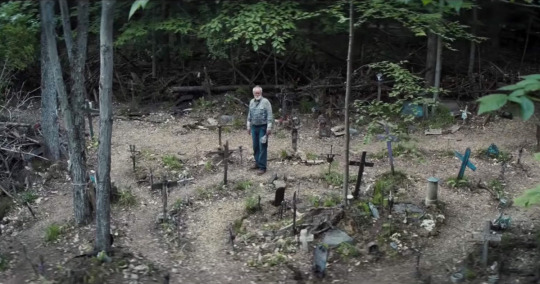
As many other people discussing this film have noted, Pet Semetary is a Stephen King story that’s notable for being so bleak that even Stephen King felt it was too dark. He hesitated to submit it for publishing for three years, only submitting it when he needed to meet a deadline for a contract. In the subsequent years, King has been critical of the “nothing matters” mentality of the story. With that in mind, as well as the knowledge that several people I follow whose opinions on film I trust were not fond of it, I was prepared for the possibility that I wouldn't enjoy it, but nevertheless open to the film surprising me. After all, Stephen King is a consistently entertaining storyteller, and I’m always interested to see how people adapt his work. For a while, things seemed okay enough. Then it started to drag around the middle, and then it took a hard, fast, ugly turn, descending into the most distasteful experience I’ve had in a cinema this year.
As that summary indicates, the set-up is intriguing enough. A family move into a new home, and there are little signs that things aren’t quite right around here, as well as the telltale indications of a traumatic past that have left some of the characters with residual hang-ups that they will inevitably be forced to confront, and the tantalising promise of something unnatural on the horizon that will draw our protagonists in as they descend into horror. It’s competent ground laying work, and apart from the horrifying past of one of the character’s being uncomfortably demonising of the sick, and a lack of a distinctive visual style for the film to call its own, I didn’t have many serious issues with the first third or so.
Once you approach the middle portion of the film, things start to feel protracted. Even if you haven’t seen a trailer or heard the gist of this story and have a decent idea about the trajectory of its narrative, there comes a point where you start to know exactly where things are heading. Discussions of death and what may or may not come afterwards, repeated reminders of how dangerous and unexpected high-speed vehicles on the road outside their house can be, and allusions to some unknowable force that can make impossible things happen which the father of this family absolutely must not approach are all dots that anyone familiar with the phrase “monkey’s paw” can join together with little difficulty. Without an engaging dynamic between characters (a la IT), a self-aware bizarreness that results in humour, or a notable visual style, there’s little to keep you going as you wait for pieces to very, very slowly fall into place.
And the final act is just awful. It spits course language and nihilistic vitriol with little substance or point to its depictions of pain, misery, and spitefulness other than to wallow in this negativity with nothing else to say. Actors start to abandon any semblance of understated nuance in favour of ham-fisted bluntness, cursing out characters with an intensity that doesn’t feel earned as they clumsily fight against them in a way that lacks any sense of climactic satisfaction, and, because your investment in these characters rapidly drains with each new questionable decision and unlikable action, there’s no tension to these encounters either. There are numerous instances where the actors will do their best to deliver lines of dialogue that try to be shocking or wryly dark, but the material is so poorly thought out that it awkwardly misses the mark in both categories. It’s especially galling as the film spent so much time and effort on getting to this conclusion that it was trying to amp up as this big, horrifying finale that will shake you, when instead it’s just underwhelming and unpleasant without any purpose to itself. I was wishing for it to end, and yet when the credits began to roll, I couldn’t help but ask “wait, is that it?” It’s a limp ending with little meaning that leaves a bad taste in your mouth.
Final Ranking: Cardboard.
Pet Semetary’s first act offers some potential, but that’s all it is: potential. The middle act spends so long getting to where it needs to be and where the audience knows it’s going that, by the time it gets there, it spends what little time it has left on cruel, structureless nihilism without taking any ownership for the unpleasant material it lays down at your feet.
Shazam!
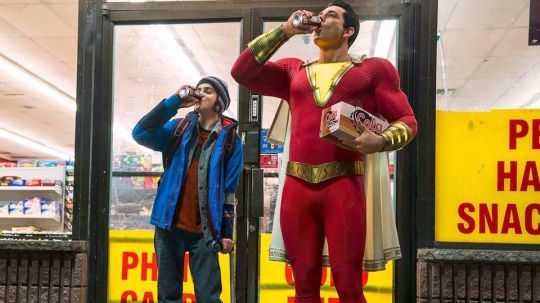
The DC movies are in a great place right now. I’ve yet to see James Wan’s Aquaman, but from the abundance of positive things I hear about it, as well as the profound impact Patty Jenkins’ Wonder Woman had on audiences, James Gunn and a whole lot of appealing casting choices being attached to the next Suicide Squad film, and the great feelings I have about the energy that the Birds of Prey teaser indicated, I’m very optimistic about the future of DC films. Now that Shazam! has released and proved to be a positively uplifting delight, my outlook on this series is cheerier than ever!
Hm? What about that Joaquin Phoenix Joker movie? Well... my feelings towards that are… complicated. I’ll save my thoughts on it for another time, but suffice to say, I think the film has the potential to be great, but I worry about the way it will be received, and that the worst crowd will embrace it and take the wrong lessons from it.
Anyway, for the here and now, Shazam is a refreshing blend of joyous levity and unexpected intensity. The film offers endearing comedy with teens and pre-teens acting like excited kids who enjoy doing dopey things but can still come across as insightful and having an emotional heart to them that makes you happy to spend time with them. But it’s never saccharine and, through a fleshed out script and a cast of sharp young actors and actresses, there’s a clear sense of authenticity which makes these adolescent characters seem grounded and well-observed. Something I appreciated is that, whenever the film goes into background details of the history of magic in this world, grandiose prophecies of mystical destinies, or the villain going into his sinister plans, it’s usually being talked about by grown adults who are taking themselves way too seriously. The best exemplar of this is Mark Strong who plays the villain, Dr. Sivana, with an intensity that deliberately comes across as hammy, and the young characters within the film pick up on this and play off him in a way that deflates his bluster and points out how ridiculous he’s being. As a result, the tone of Shazam! feels like it’s poking good-natured fun at prior DC projects and other big budget action blockbusters where stone faced adults spout clichéd speeches without any sense of self-awareness. It’s an approach that points out how some modes of behaviour that are often associated with maturity and being an adult are actually quite childish when you take a step back. As a superhero film that focuses on the experience of being the age where you’re young enough that you still enjoy being a kid, but old enough that you want to call adults out on their bullshit, Shazam! is impressively realised and fun as hell.
But for as light-hearted as it can be, Shazam! nevertheless surprises you with the occasional brutal sequence that catches you off guard with such rapidity that I found it relatively shocking. It’s not so detailed, gory, or explicit enough that I’d say it goes too far, but it’s worth bearing in mind before you show it to a particularly young and impressionable viewer. The benefit of these sequences is that the unexpected escalation accentuates how in over his head Billy is when he eventually comes across a situation that’s genuinely dangerous, as, despite his newfound powers, he is still a kid, and he really shouldn’t be facing this kind of thing. Indeed, the film demonstrates an impressive grasp of and dedication towards themes of maturity as Billy faces difficult truths about something he thought he wanted and realises he’s been looking in the wrong place for what he actually craves, as well as develops into a more responsible version of himself that opens up to being part of a group built on mutual trust. There’s a cleverly subtle visual indication of the progress Billy has made by the end of the film where he remembers to lower his head as he walks through a door while in his superpowered adult form. One of the first things Billy does when he first transforms is hit his head on a train door to show how unused he is to this new body. The simple act of Billy seeing the doorframe and lowering his head as he steps through without any hesitation near the end of the film signifies the control Billy has developed over himself and his own actions, making his journey of maturation resonate that much more with me. The impact of shocking dark turns and the firm, confident grasp the film has on its cohesive themes of maturation and finding your place in life elevates Shazam! from a fun time to an uplifting and refreshing story that I think people are going to really enjoy for a long while.
Final Ranking: Silver.
Energetic, full of character, and with a strongly executed theme of maturation, Shazam! is highly recommended. It is perhaps a little longer than it needs to be, which results in the latter parts of the middle section feeling a little drawn out. Having said that, the finale sends a jolt of electricity through you that makes you forget any objections you might have and remember all the positive qualities that make this film so likable.
Hellboy (2019)

Oof… why did I decide to end this collection of reviews on Hellboy (2019) and write this after three other sections? Sigh… okay, let’s get this over with.
It would be insincere of me to say I'm the most impassioned proponent of the Guillermo del Toro Hellboy films. I found them memorable and atmospheric, and you could certainly feel the characteristic flair from the many people that put their artistic touch on those films to create something unique that marked them out from other comicbook movies, which is especially impressive in the mid-2000s, pre Iron Man era. But after going through the slog that is Hellboy (2019), I think I’m more appreciative than ever of what del Toro and his team managed to achieve.
For a while, it seemed like this new R-rated version of Hellboy was angling for a more faithful adaptation of the original books by Mike Mignola, given the various interviews that were had about it over the years. Sadly, the final result feels like the result of too many outside influences dictating what the film should feature, culminating in a hodgepodge of a film which regurgitates character beats from the del Toro films, and rapidly stitches together a half-hearted attempt at a King Arthur narrative to fill in the requisite new material (this is your regular reminder to check out The Kid Who Would Be King, a much better modern reinterpretation of Arthurian lore). The presentation is dour, unenthusiastic, and lacks any atmosphere or personality, and that is something you could never accuse either the Mignola books or the del Toro films of lacking. In the whole film, there are only two sequences that stand out, namely the fight with the three giants and the rampage of the hell creatures in London. Even so, the former is a relatively meaningless sequence that contributes very little to the narrative and lifts right out of the film, while the latter is so sadistic and mean spirited that it made me genuinely uncomfortable. It falls flat as both an adaptation of a beloved fictional series that’s brimming with atmosphere, and as a piece of technical filmmaking as well.
On top of that, when the tone and general philosophy of the film does emerge out from under the rest of the film’s mediocrity, it reveals itself to be genuinely unpleasant. The film opens with narration that rushes through the backstory with Nimue and the Arthurian set-up and does so with foul-mouthed irreverence. There is a bit of humour to someone casually tossing in the odd bit of shitty language as they tell you about ancient history that should be discussed with pomp and circumstance but is instead being discussed with ill-fitting coarseness. However, there needs to be some personality to go along with it, otherwise it’s implied that the swearing is the character and all that’s there to it. In the case of this opening narration, Ian McShane emphasises each fucking swearword and it becomes clear that the dialogue is using this as a crutch in an effort to make the film seem like it has an identity as this edgy superhero movie that’s different because it swears. It’s a juvenile approach that is laughable when you consider how effortless Ryan Reynolds’ delivery in each Deadpool movie has been, which demonstrates how swearing can be used to accentuate genuinely funny jokes and characters, rather acting as the joke in and of itself.
And this isn’t even the most egregious part of the film either, it’s simply a bad first impression. The worst aspect of the film’s outlook is how virtually every character espouses the notion that you should stop complaining, stop letting things get to or affect you, and stop taking time to process things. This is especially saddening when Hellboy’s father, a character that was played with wonderful vulnerability and heart-aching humanity by the late great John Hurt, tells Hellboy to “grow some balls” and get on with things, making the emotional culmination of their time together on screen essentially boil down to ‘quit your bitching’. Characters in Hellboy (2019) show next to no empathy towards one another, and they continually reinforce the story’s outlook which, whether inadvertently or not, nevertheless encourages a state of being where you never have time to be open or vulnerable with the people around you. It’s profoundly disheartening to watch, and gives little to no thematic or visual sustenance to get you through a runtime that feels far too long.
Final Ranking: Manure.
David Harbour does an admirable job in the lead role and I was happy to at least have a protagonist in this film that captures the gruff sadness and down-to-earth affability of the character of Hellboy. But he’s drowning in limiting makeup and an even more stifling movie that has no visual flair and a boring, miserable narrative. The experience of watching this movie is draining and deflating, and I hope to never revisit it.
#The Inquisitive J#film#movies#film review#movie reviews#critic#film critic#movie critic#film criticism#independent film journalism#missing link#laika#missing link review#pet semetary#pet semetary review#shazam!#shazam! review#hellboy 2019#hellboy 2019 review#the inquisitive j reviews
7 notes
·
View notes
Text
Not My Narrative (on extremist feminism)

This is the reason that when people start talking about feminism, I feel the urge to get up and leave the room. I don’t have a problem with feminism itself. What I DO have a problem with is when feminism pretends to be everything for everyone.
I want to try and put words to something that I have an intense amount of anger about and which I want to get out on a page as a means of unpacking.
If you’re LGBT and you’ve watched stuff on YouTube, you will have come across at least a handful of incredibly ignorant homophobic or transphobic comments. Sometimes these are violent in tone, but other times they are more subtle... condescending. It’s that later kind I want to talk about because sometimes that kind makes me more disgusted than the outright hate.
This post is about a specific comment that I saw one day under a video made by a lesbian woman. The comment was a response to something I said under the video in defense of trans guys. I was trying to make a distinction between butch lesbians and trans guys, because it is obvious that some people still can’t tell the difference.
The woman’s comment did not in any way or form acknowledge what I was saying. In fact, it didn’t even acknowledge that I even had a voice. Basically, she was saying that transgender people were people with “internalized sexism” or “internalized homophobia” and that this was the reason they go for medical transition. She said that she works with women who have regretted transitioning and that there always seemed to be “internalized sexism” going on.
I responded to her back and fourth a couple of times. But after a certain point, I had to tear myself away from the conversation because it was so one-sided that I might as well have been talking to a stone wall. I don’t believe in one-way discussions, and I don’t believe that matters of personal Identity are up for debate. So I stopped responding.
This incident stayed with me and even years later it occasionally plays back in my head. I wish I never saw her comment because it’s the kind of thing that makes a person hate humanity. It makes me wonder how many more people walk around the world thinking that transgenderism is “self-hate” or medical transition is “mutilation”. Nowhere in this “conversation” did she even recognize that I have my own perspective; it was calm, self-assured condescension from start to finish.
I stopped responding because I’m smart enough to know that the person who gets the last word is not always right. She got the last word, but I didn’t bother reading her last reply because I didn’t want to continue that loop of bullshit. The incident left me with an unpleasant memory that plays back like a trauma in my head at random times, simply because people don’t forget the feeling of being belittled easily.
Cis female experience is NOT my narrative. My dreams and fantasies have been consistently and even stereotypically “hetero male” since I was a kid. What I’m attracted to and what I identity with have always existed in two separate boxes in my head.
I read this line in a book once:
“Models of understanding are ways of seeing a thing--not the thing itself”
Extremist feminism doesn’t seem to get this.
Do those who de-transition exist? Yes. Are there people who have internalized sexism? Yes. Are there people who transition purely for privilege? Yes. That still doesn’t mean that all who say they are Trans are like this.
My narrative was NEVER the cis female narrative.
How do I put this simply? When I was a kid, I wanted to grow a penis. When I was a teenager, I wanted to grow a penis. When I was in my early 20s, I wanted to grow a penis. Even now, in my late 20s, I still want a penis. And even on my deathbed someday, I will hope that in the afterlife I will finally be a guy.
That’s not confusion. That’s called consistency. It’s called knowing what I want.
That was the way it always was—long before I knew the words “queer” or “trans” or “cis” or “feminism”—long before I knew my sexual orientation even. It was my #1 dream as a kid and always will be, regardless of whether I can ever make it come true or not. As I said before, the only thing that holds me back is the lack of a magical and painless way to make that dream come true.
Seeing that kind of transphobic garbage that is so wholly disconnected from my actual experience… I don’t even have the words for the disgust I felt. And it was even more traumatic because this was at a time when I was getting ready for top surgery.
This kind of extremist feminism damages the psyche of those who are not cis. It is a true abuse of power when one person feels they can silence another person in full confidence that society will back them up in their oppressive behaviour. It’s a sign not only of the power-hungry nature of some individuals, but also of the corruption in a society… the fact that society hasn’t developed enough to protect the rights of an Individual because they cause an inconvenient disturbance in the neatly constructed dominant narratives. It’s a sign that some people are being given undue power over others’ lives and bodies.
I definitely don’t have “internalized homophobia” because for a time I was perfectly willing to use the label for queer female, even if I didn't feel any resonance with it.
As for “internalized sexism,” it’s complicated. It’s very hard to talk about something like gender dysphoria with full honesty without coming off like I have some kind of sexism going on. But the word that I wholeheartedly reject is the word “internalized." That word starts with the assumption that my true self is Cis. It’s not. It never has been. It’s one thing for someone to claim that trans people have some level of sexism but to claim it is “internalized” is yet another kind of invalidation.
You can’t have “internalized” hate about something you never identified with IN THE FIRST PLACE.
I wondered for the longest time why my journey didn’t feel like it ended when I came out as bi and then gay and then non-binary. It was only after watching (binary) trans men talk about their experiences that I really TRULY felt I understood myself. Even when I came out as “gay” it was reluctantly and I never thought to myself “I want to be someone’s “girlfriend.” When people looked at my relationship, I wanted it to be obvious that I was the guy in the relationship. I still remember looking for a lesbian couple that actually reflected what I wanted (to be the GUY in the relationship) and I saw a couple online that I identified with because one of them behaved more like the masculine one. Fast-forward several years, and that same person came out as TRANS male! It didn’t surprise me at all.
People can talk down to me, they can talk around me, they can talk about me but one thing I will never allow them to do—and which they can never do—is talk FOR me.
That’s what that woman in the YouTube comment was trying to do in that moment. She was trying to talk FOR me. And that’s why I felt such strong emotions and that’s why that interaction still makes me want to punch someone. Nothing in the world feels more dehumanizing that the feeling of someone taking an eraser and erasing your whole life just so they can make sense out of you for their own purposes.
I felt erased in that moment. How do you tell a condescending, arrogant stranger that when you were a kid you used to watch TV shows and wish with pained longing that you were the male characters, every time? That you felt extreme discomfort when being around girls your age because the stuff they talked about didn’t make any sense to you? And you didn’t care because you wanted to be with the guys instead… not in a sexual way, but in a “bro” way. How do you convey that for the longest time, you were a loner because you didn’t fit anywhere and that even years after coming out these scars still haunt you?
The ridiculous accusation of wanting privilege only makes me roll my eyes. Of course a cis woman wouldn’t possibly be able to understand why else someone would want to BE a guy! Their very brains are different. If you can’t see the worth of basic male experiences (brotherhood, fatherhood, boyfriend, husband, etc) then your head doesn’t work like a guy’s head. If “want of privilege” is the only reason you can imagine wanting to be a guy, you are not a guy on the inside. You are not binary transgender and you are likely to regret medical transition. But don’t ever apply that to me. I’m not the same.
Do these people think that cis straight women know how cis lesbian minds work? No. They don’t. And yet, they accept lesbian women all the same. There should be NO reason why lesbian women or straight women can’t do the same for trans guys.
When someone feels the need to overwrite another person’s identity, it’s usually because of some kind of deep insecurity of their own. If people really believed in gender equality, then it shouldn’t matter if someone wanted to jump from one gender group into the other. It would not affect anything. Obsessing over other people’s gender transitions is what true obsession with privilege looks like. That’s what socially sanctioned narcissism looks like.
The only surgery I had was top surgery. It’s been about 3 years since then, and I can tell anyone with full confidence that “Regret” is not a word that would even be in the vocabulary I would use to describe the good it did for my mental health. It was like something extinguished a deep rage that was centered on my chest area. Eternal Gratitude is the only thing I feel, towards the surgeon that gave me that release and empowerment.
I had to force myself to write this post because it meant reliving a memory I'd rather throw into the trash. I just hope that someday there will be cis people out there that can see that kind of interaction clearly for what it was: one person abusing their social privilege and power over another. I hope that someday society will develop enough to look at that kind of abusive person with the same disgust that I feel, and to see that some models of understanding are flawed and only serve one group.
It’s incredibly easy to pick on minorities and to make up all kinds of fictions about them, because in a society full of ignorance, whose is going to stop you? All throughout history minorities have been considered mentally ill for being different, and each time society developed enough to see how wrong their assumptions were. What’s sick and sad is that even after all that, people are still doing this in one form or other. That’s what makes it unforgivable. With that much history to look back on and learn from, to do it again in another form is unforgivable.
As for accusations of “self-hate,” there’s nothing more self-loving than standing up against a whole group of self-entitled people and rejecting their assumptions in defense of one’s truth.
The “Realness” of my experience is something only I and others like me can know. Whatever fiction someone tries to put on top of my reality ultimately does not erase that reality. Transphobic people and the fictions they make up to make sense out of something they don’t even seem to want to understand—those fictions are not my narrative.
3 notes
·
View notes
Text
DR1 character rankings
I got bored and kept seeing @halfpastmonsoon do these and decided fuck it I’ll do it myself. It’s my blog right like?
Anyway uh in case someone gets super irate about it these are just my opinions and you’re allowed to like characters I don’t like for whatever reasons you want? You’re also allowed to hate characters I like! But isn’t an invitation for you to fight me just because I have different opinions, yeah? Okay! Under the cut!
1. Kirigi//ri Kyou//ko: she’s my god damn wife what do you want from me. I’m really gay did you see her in DR3--OKAY NO FOR REAL. Kiri is so good holy shit she’s like morally complex because she’ll do anything for the truth, even throw you under the bus just to make sure she can still live to find it. She’ll get mad at you for keeping secrets and yet she’ll keep like 8000 from you and except you to roll with it. My point is Kiri has flaws, but more importantly, she has like an arc where she learns from them? Like with the secrets she realizes she was being unfair, and when she throws you under the bus it’s when it clicks just how she was gonna KILL Naegi just tomake sure she could keep operating as herself. She realizes her mistakes, and she comes clean on all her secrets and apologizes. She’s got a lot going on. And I love her so so so much.
2. Oo//gami Saku//ra: too good for this fucking sinful earth. okay. No, but seriously I think she’s amazing simply because of her arc. She betrays them all in a moment of weakness, because she fears for her dojo, and over the course of getting attached to them realizes she can’t throw them all under the bus like that either. So she resolves herself and finds the strength to fight Monokuma, and suffer alone as consequence to her actions. But even that’s not enough. It’s not enough to just accept you’ve sinned and take your punishment, you have to do something, and she does. Through her own strength and love for the classmates around her she kills herself just to end their fighting. It stopped being about her, and just...grijgoirjgoirjgowe okay I love her.
3. As//ahi//na A//oi: throwback to when the consequences of trying to get everyone killed mattered even a little! I love her a whole lot! She’s super bubbly and excitable and tries quite a bit, but the thing I like the most is how she’s is pretty much exclusively run by her emotions. ch4 plays out the way it does because she gets so caught up in her guilt instead of thinking it through more she decides they all must die for their sins. It’s only when she’s forced to think about the ‘suicide note’ that she recieves she realizes she fucked it up, and then apologizes. Her apology is glossed over a little too fast if we’re being honest, but it’s there, and we see everyone reason their way into forgiving her. Listen I just like ch4 a lot and she’s a big reason as to why.
4. Eno//shima Jun//ko: throwback to when DR villains were actually good and compelling. Girl makes a fucking entrance and she stands out because she literally can’t decide what she wants to be out of boredom. It becomes so clear just in how she treats herself that the only thing in this WORLD that matters to her is her own entertainment and that to her, entertainment means despair. Boredom is the one true despair, and it can only be satiated by seeing other people suffer at their worst. She embodies despair because suffering is the only thing that can satisfy her own personal despair. She wants everyone to suffer like she does, so she can get off on it. It’s paradoxical and mad, but it’s genuine. Even when she loses, she wins, because now she suffers from the despair of failing. She suffers because things don’t go her way, but things not going her way alleviates her boredom. She goes beyond human comprehension and yet her actions have very real and permanent consequences. And she’s a joy to watch. DR3 never happened to ruin her. Nope.
5. Fu//kawa To//uko: Man I love Fuka//wa I really do she’s a lot of fun, and it’s just a shame her potential isn’t capitalized until DRAE, but I did enjoy seeing her. The serial killer twist is fun too! I’ll admit I largely like her because of what DRAE does for her, but I think her persecution complex is interesting to see in motion, and that for someone you’d expect to be smart given her talent she’s just kinda a fool. She doesn't actually know what she’s doing at all. I’m mad she doesn’t get her moment in ch6 and it goes to Syo instead I think it’s crap how DR1 ignores her as a character, but given how well she’s used later I think DR1 is basically just her backstory in a lot of regards so ye.
5.5 Genoc//ider S//yo: lmao she gets ranked less than Fuk//awa only because I like F//ukawa slightly more but they’re pretty much tied otherwise. She’s funny. I’m a little annoyed that she’s the one with the big climactic dialogue in ch6 versus actual Fukawa but whatever man.
6. Fuj//isaki Chihi//ro: y’know I had like several paragraphs here as to why I ranked Fujisa//ki here and then I realized the discourse I’d reopen on the subject is not worth it because Fujis//aki Discourse is eternal and no matter what pronoun I use someone would fight me SO. We’re just not gonna explain why. You’re just gonna have to accept it. I’m not doing Fu//jisaki discourse. If you message me on the subject, I will ignore you. The end.
7. Na//egi Mako//to: Egg is a super static character if we’re being honest. He makes no change and doesn’t develop, but I think it was actually the point. I pretty much exclusively prefer a character who develops, but egg does his job well because he was meant to be SYMBOLIC of hope. Hope is not something that changes, it simply IS, so having him start optimistic and trusting, and remain optimistic and trusting works because he embodies the concept he represents. It’s kinda boring that it feels like he’s a vehicle to view the plot, but he works, and he’s a little funny at times. Also, I’m gay for Ogata Megumi so there’s that.
8. Ishi//maru Kiyota//ka: Honestly I think Ishi is kinda boring, but I just really like that he got suuuuper invested in Oo//wada only to crash like. I think Kodaka doing that and realizing how bad people took Ishimaru’s later death made him start having actual development arcs based on someone else’s sacrifice which is good. So at the end of the day, I like Ish//imaru if only because of what he inspired. But he’s kind of a cute character, and his “not actually gay we promise” dynamic with Oow//ada was fun.
9. Hag//akure Yas//uhiro: For comic relief he’s actually kinda funny although I will never never never forgive the man for “Kiri//giri-chi is a ghooooost!!!!” shit in ch5 listen no fuck off fuck you she’s not a ghost. But he’s useless, but it’s kinda funny how useless he is, and I like how his useless stupidity actually plays a role because he makes things even more complicated than they need to be in ch4 because he’s dumb. So there you go.
10. Ik//usaba Muk//uro: She like has no real character as a result of like not actually existing as herself in the 2 minutes of time she gets before she dies so I don’t know how people stan her, but I think there’s something interesting about her pretending to be someone she’s not the whole time. You see more of that in school mode, but I wish there was more of it in the main story to hint at the reveal than her DEATH. I feel like she’s a lot more interesting in theory than in practice.
11. Oo//wada Mon//do: I just don’t care about the man what do you want from me. He’s kinda funny though, and “his totally not gay we promise” bromance with Ishi//maru is nice. Also ch2 hurts sufficiently and provides interesting commentary on toxic masculinity. But honestly, I just didn’t really get all too invested in the guy. His design’s cool though.
12. Ma//izono Saya//ka: she’s just really boring guys she’s like not interesting at all, and I don’t appreciate the game forcing her on me just for a plot twist of ‘oooo she dies and was gonna frame you for murder!!!’ There’s like nothing To her, and she’s intentionally played like wife bait so the reveal hurts more but it doesn’t really work when you’re not taking the bait, huh? All that being said I actually kinda like that at the end of the day she ISN’T wife bait and she’s kinda conniving and manipulative, but Kodaka decided we have to preserve her as “ultimately good” with that “dying message means she really does care” thing he hammers in so she’s a little wasted. I’d like her more otherwise.
13. Yama//da Hi//fumi: He’s creeeeeepppyyyyyy. I’ll give him credit for one thing though and that’s like his creepiness is like reserved towards an AI? Like he’s not like a certain sdr2 character who I won’t mention by name, but like it’s still. It’s not good. Also for comic relief, he’s not very funny. But I also just kinda feel bad for him because his existence is treated as a joke by everyone, even the writers, and that probably explains why he’s written like that, to begin with.
14. Ce//lestia Ludenb//erg: She’s a bitch? She’s not even a fun bitch she’s just a bitch. I just don’t like her better than thou attitude before her reveal, and her motivations after her reveal in ch3 did nothing to endear me to her. I think the writing behind her though works, which is good. The plot twist is satisfying for that reason. She’s like Ouma jr in regards to the DR Liar archetype, which is great tbh, and she has payoff, I just don’t like her as a person so she’s super far down my list lmao.
15. Toga//mi Byak//uya: listen he’s a douchebag and gets no real character development at all. like in ch4 he decides he’s gonna stop playing the killing game how Monokuma wants, but he still is the same fucking condescending better than thou asshole he started as. His major character flaw ACCORDING TO THE NARRATIVE is that he’s a self-absorbed piece of shit who thinks he's right about everything all the time, and yet even when he gets WRECKED in ch4, he like...stays the same. Instead of thinking “maybe I’m wrong sometimes” the conclusion he reaches is “I’ll stop doing what Monokuma wants” which alright fine but like that’s not the arc we set up for you. So basically Togami from start to finish is just a douchebag with no actual redeeming qualities. I will say one thing. I like him MUCH better outside of DR1, where he seems to have actually developed a little, and he’s kinda funny. Also his backstory is fucked I’ll admit that. But dude I don’t like the man.
16. Kuwa//ta L//eon: If you’re wondering why Leo//n’s down here at the bottom even if I just professed to hating Toga//mi with my entire being it’s because I very aggressively don’t care about him. He is a non-entity to me. You could erase him from my memory and nothing would change at all. Also he’s ugly.
11 notes
·
View notes
Text
AX2002 - Dimensions Group Project: Storyboard and Script
The Dimensions project is an animation where each 30 seconds, the animator switches. The aim of this brief is to get us to communicate with one another and be able to present a cohesive chase sequence with a clear narrative.
When it came to planning this out, we needed someone to be at the front and set up the narrative clearly. Before anyone could, I put my hand up. I was starting this off, I had the perfect idea that established Vasyl as a strong no-nonsense character and Skip’s more easy going and laid back approach. I knew how to set up these characters, so the rest of the class would know what to do, understand the relationships and mechanics of the characters.
First Storyboard Draft
The first impression I got for an introductory segment was to set up a tense narrative with multiple things going wrong at once. Setting a tone where our characters HAVE to get Guffyn back or it’s absolute disaster for everyone! So, immediately the ideas came flooding in and I scribbled down a rough storyboard. The visuals came to mind first, linking them up with a loose narrative. There wasn’t a definite script yet at this stage.
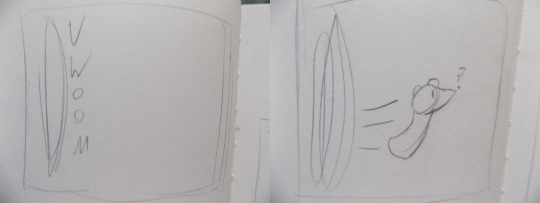
So, this animation “begins” with Guffyn opening a portal in time and arriving into a quiet alleyway in the night. Here Guffyn is rather confused, giving the impression that Guffyn doesn’t really know where it’s going. This was supposed to be the ending shot to the whole animatic, where it loops back to the last frame of the film will mirror the first.
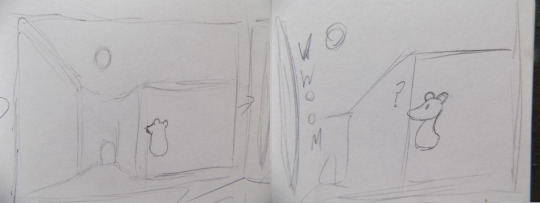
This is where my segment really begins, with Guffyn looking off at the moon for a few seconds before a portal opens to Guffyn’s side with them looking at it in confusion. I always wanted this shot to be the opening shot, have the alleyway there with a little entrance and the moon in the sky.
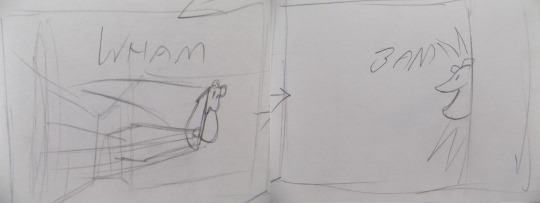
A foot zooms through the portal, hitting Guffyn and slamming them into a wall! This violence was to establish a more urgent tone because who would want to stomp on a small cute creature like Guffyn? Not unless it was absolutely necessary, showing the audience that this character means business.
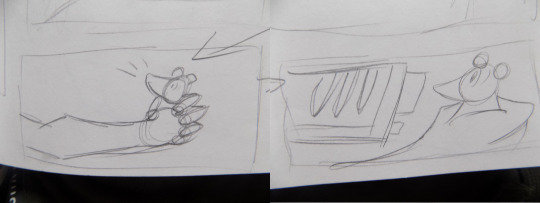
An aggressive hand came in, grabbing the Guffyn tight causing it to let out a squeak! A huge gun is then pointed in Guffyn’s face, with a closeup of Guffyn’s shock! This was to make Guffyn look that much more innocent and small in comparison to the huge hand and gun.
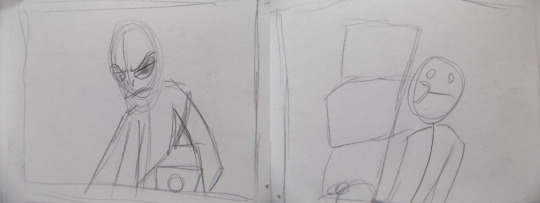
Finally, we see the aggressor, Character A! Not named at the time. Pointing the gun at Guffyn in a POV shot, we get to see their rather intimidating appearance and are only left with vague answers on who these characters are. Then, a hardcut to Character B! Taking out some boxes, the designs here are both simple just to block out the scene and what’s happening. We hadn’t finalised any designs or even discussed them before this, so kept it to know what I’m doing. In hindsight, not a fan of how little Character B is actually in this, and so this was changed in the next scripts and storyboards.

Character A shoots out a portal to take Guffyn back. This establishes the whole narrative of things going wrong when Character B trips up and accidentally stumbles into the portal, much to Character A’s dismay.
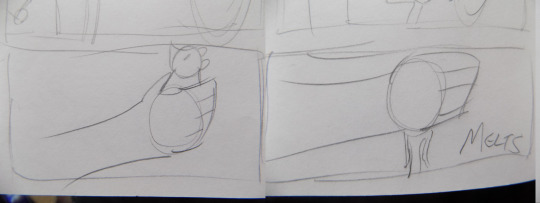
Seeing a chance to escape, Guffyn transforms into liquid and melts out of Character A’s hands.
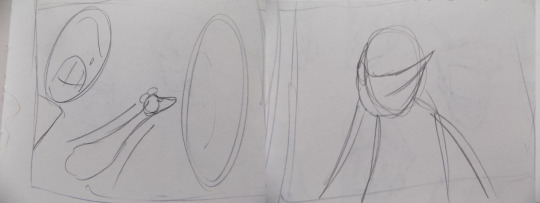
Guffyn then flies into the portal as Character A tries to grab them before they go, but fails... Character A groans saying something like “Not again...”
Summary
This storyboard was a perfect foundation to build upon, the setting was something I really liked and Character A’s reactions where perfect for setting up that there’s more to this story, however this draft has several problems.
My biggest being the portal Guffyn escapes into, would not have been a random dimension as Character A shot the portal, it would have been to go back to the facility which Guffyn had escaped from. Thinking from a story standpoint, Guffyn would have gone back to where he escaped from and Character A would follow, catch them without a chase and also return Character B home without any mad chances between dimensions! This would have also meant that Bee would have to have set her animation in the WTF facility and that wasn’t exactly fair in my opinion.
That was my major problem, but I also didn’t like how Character B hardly interacts and I don’t get a chance to set up Character B’s personality. So, back to the storyboards, I had to find a way where Character B plays just as much of a role in the setup, where Guffyn manages to escape by it’s own rules and an animation that won’t conflict with Bee’s aims and wants in her own segment.
Second Storyboard Draft
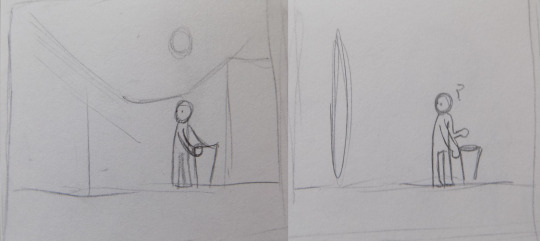
So, working on my problems with the first board. This version actually begins with Character B taking out the trash, the same sort of shot of the alleyway with the walls, entrance and moon in the background. Suddenly, a portal opens up that catches his attention.
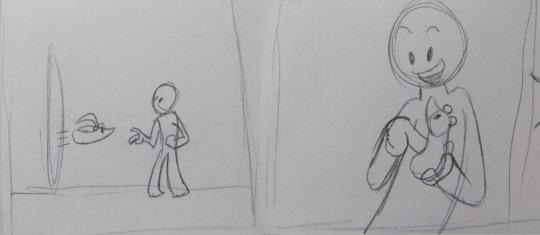
Guffyn flies out and into the arms of Character B, very fast and conveys the impression that Guffyn is escaping. A small level of urgency established as Guffyn takes comfort in Character B’s arms and we get to see that Character B is a kind and caring character...

While Character B is preoccupied with Guffyn, a gun points into view which causes them to jump and look up in shock! It’s Character A! Looking all intimidating and menacing while pointing an alien device into Character B’s face! Quietly and calmly telling Character B to let go of the Guffyn...
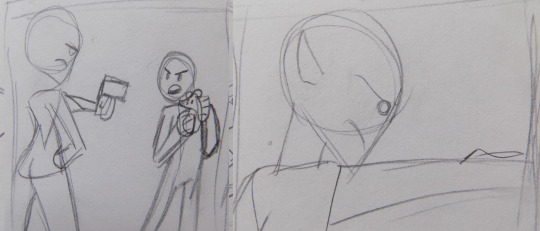
Character B turns away, claiming that Guffyn is harmless and that it likes him! Character A establishes that Guffyn is actually capable of many things and that it has the capacity to destroy dimensions, not once lowering their gun. Showing how contained and composed they are.
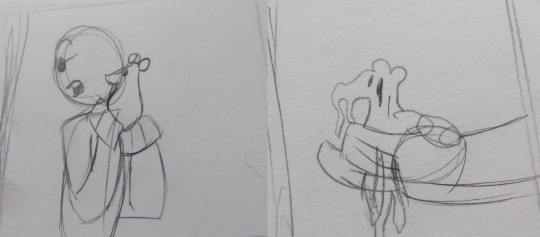
Character B steps back claiming that it might not want to destroy worlds. As they argue, Guffyn melts through Character B’s hands.
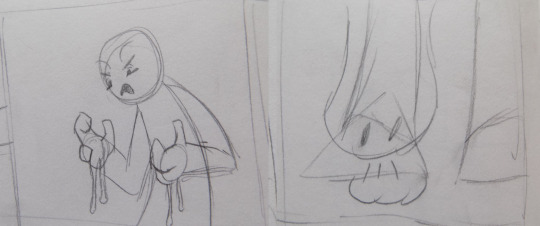
Character B reacts in disgust, letting Guffyn drop to the floor giving it a chance to escape! I’m quite a fan of how I got to keep the melting effect.
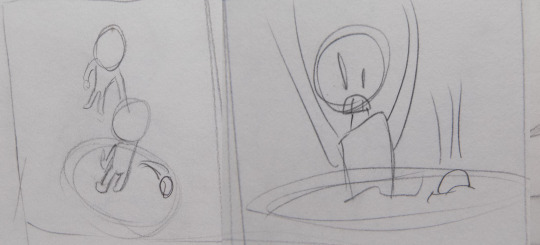
I’d noticed how flat this might have been laid out, so I decided to do this high angle shot to show the portal forming under Character B. Not only to be visually interesting, but to challenge myself by drawing at that angle. It also shows where the portal is formed and also accidentally brings Character B into the adventure!
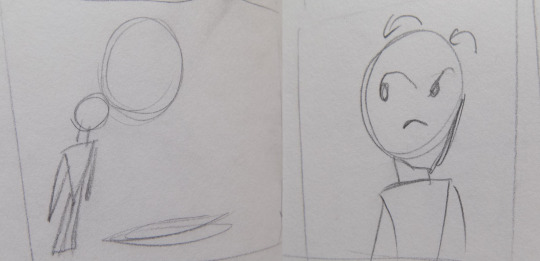
Now alone, Character A reflects on what just happened and simply wonders why their job can’t be easy.
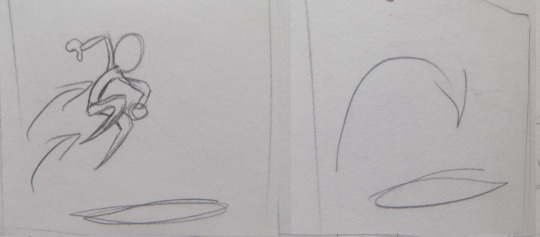
Character A quickly jumps after and my segment ends...
As you can see, it’s almost the same. However, just simply rearranging certain aspects to make a much more refined film. Elements like Character A being left alone and Guffyn melting away to escape. The violence and urgency much more toned down and in a sense reversed, since Guffyn is all cute and cuddly until it’s revealed that Guffyn can be weaponized. Making him more of a threat rather than make him innocent throughout and making Character A the aggressor.
With this rough draft done, I then began to write a script and create a much more refined product.
Script Development
With my new foundations, I began development on the script and storyboards. This time however with my artstyle in mind and something that will be much much closer to a finished product.
When writing the script, I had to keep in mind the character’s personalities. Character A, a headstrong, determined figure that has no time for nonsense. Character B, a lighthearted and accepting guy that won’t hesitate to show kindness to the most dangerous creatures.
With these attributes in mind, I gave Character B the name, Skip. His last name was going to be Anajump because what I was originally going for was a name based on the phrase, “A hop, skip and a jump away“. But, that wasn’t necessary.
Character A became Vasyl, a name in some languages that means leadership and independence. I felt it was important to give them a foreign sounding name since they are an alien.
When I pitched these ideas forward in the group discussions, nobody seemed to object and the names stuck!
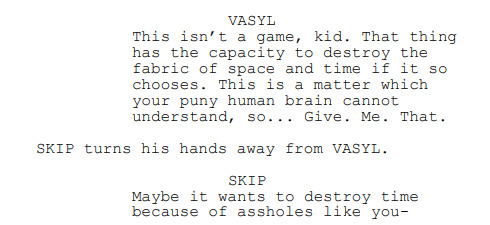
These characters went through a bunch of developments, character-wise and visually. Both Vasyl and Skip had lines where they swore in initial scripts, while it felt in line with Vasyl’s character, it didn’t feel right for Skip, plus it made him less endearing. He just seemed like any old teenager than a kind hearted youth!
Their personalities remained the same, but when the brief asked for a sudden detail to be revealed that changes the dynamic, it definitely got me thinking. A rough idea I came up with was have Vasyl grow a bond with Skip because she knew a relative of his who had died on their adventures, seeing those key traits she saw in them. Specifically in regards to his kindness. And just before they part ways, Vasyl would make a comment like “The boy’s just like you”. This idea was soon shot down as it was a little complicated and to keep characters down to a minimum, I didn’t want to restrict people into including certain details.
Another idea I entertained was Vasyl knowing everything that was going on while Skip had no clue, so when she first appears it’d be like “Not again! No time to explain, follow me!” This didn’t really work for me and I preferred having them meet for the first time.
Storyboard Development
Now I had names, designs and direction for the story to go in. All that was needed was to rebuild my vision and get it more clearly across...
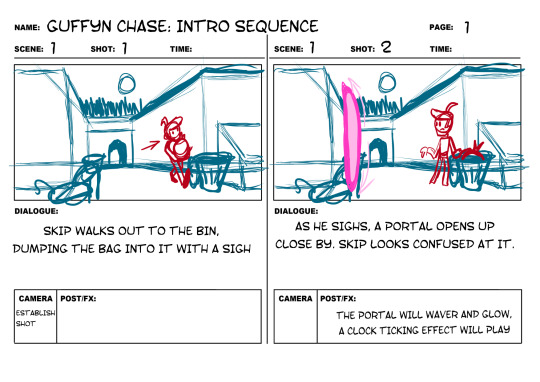
So, we establish that Skip is just a regular human with a regular job in his regular routine. Just having him sigh establishes he is a little bored of his usual life.
Skip’s reaction to the portal opens also establishes that the wacky adventures that he will embark on throughout everyone’s animation would be completely new and mind-boggling to him.
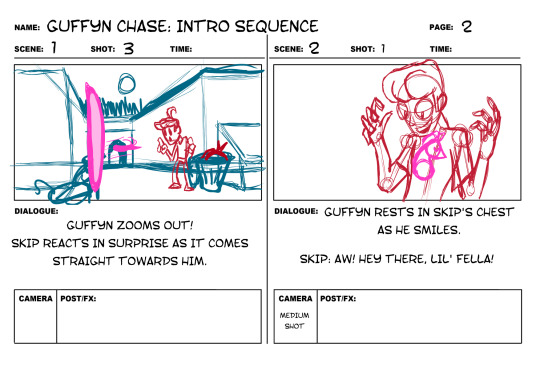
Guffyn flies out, straight into Skip’s arms. Making it seem defenceless and innocent.
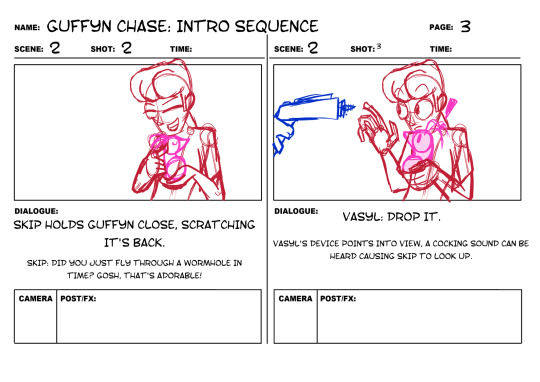
Skip’s reaction to Guffyn is nice, we see his open-mind and kind heart. His and Guffyn’s shock when confronted with a big tall alien woman with an unusual device gives the audience the initial expectation of Vasyl being the antagonist.
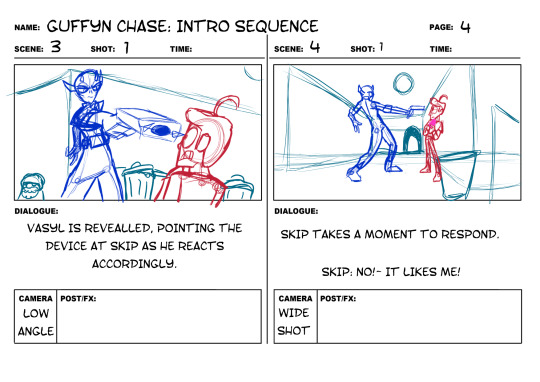
A small pause to let the bizarre-ness sink in, building tension as Skip refuses to answer her. We see Skip takes a few seconds to pluck up the courage to say know.
Vasyl’s gun was changed to look more like a taser and device, make her look like she’s using a tool rather than a weapon.
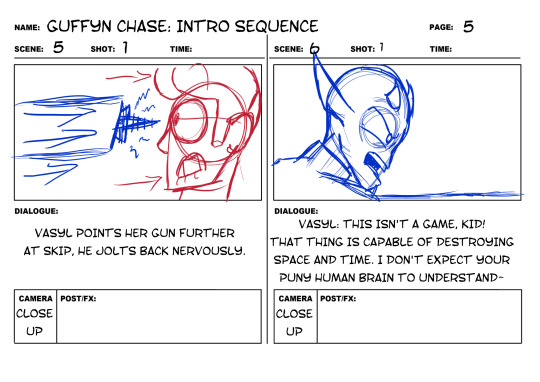
Vasyl’s rant and expression shows the audience that there’s more to Guffyn than it seems, maybe it is not to be trusted.
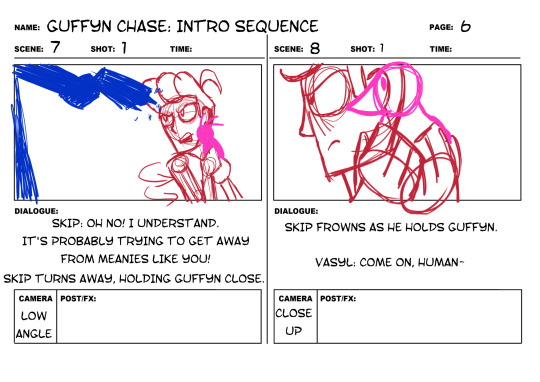
Taking advantage of the situation, Guffyn melts into Skip’s hands in an attempt to sneak away unnoticed. This is set up into the ending of Alex’s animation, where Guffyn takes advantage of the situation to escape.
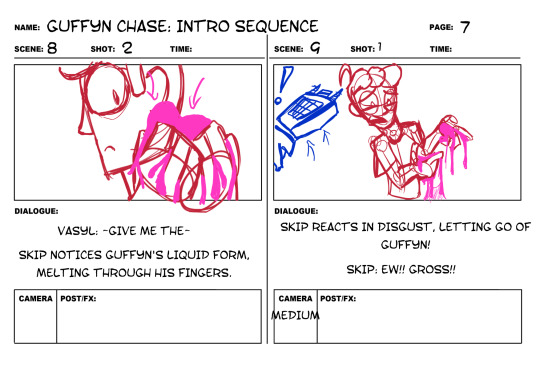
Skip notices Guffyn leaking through his fingers and reacts accordingly! Vasyl jumps back in surprise due to Skip’s sudden recoiling.
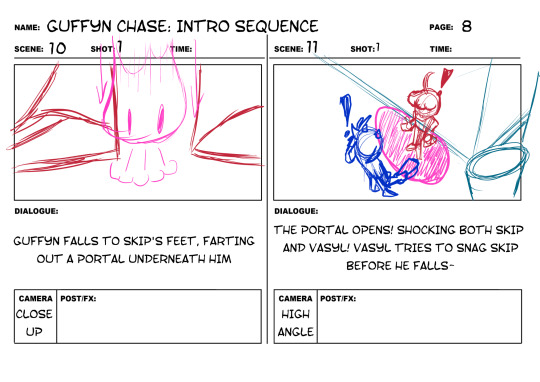
Vasyl’s attempt to save Skip is the start of their alliance, showing the audience that Vasyl doesn’t want to drag innocent lives into her job.
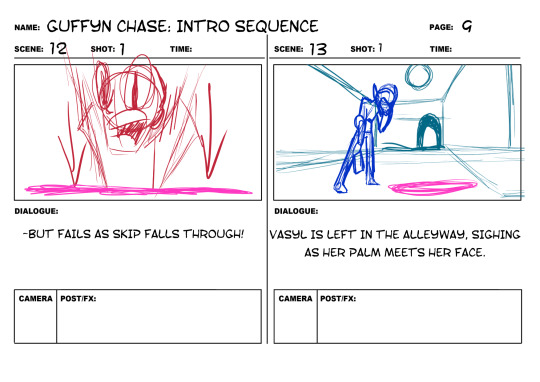
But, alas, Skip falls into the portal. Getting dropped feet first into the conflict, Vasyl can only react in disappointment...
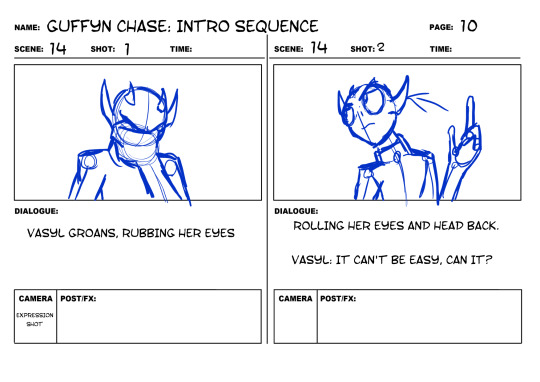
Her casual reaction sets up a drier side to her personality, showing how these unusual situations are a regular occurrence to Vasyl.
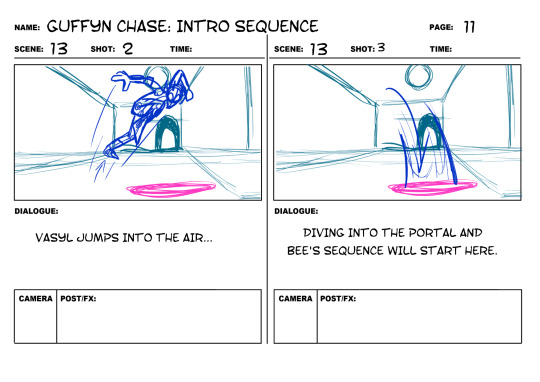
Vasyl jumps in after Skip and straight into Bee’s animation with them falling down. Which further goes onto establish Skip’s kindness and Vasyl’s casual attitude to this situation.
Summary
Being sure in my vision, I simply continued in this direction and made some animatics with test audio. Hardly anything story-based changed from now until my final animation unless it was purely visual. I was really happy with how this turned out and I was even more happy about bringing this to life.
0 notes